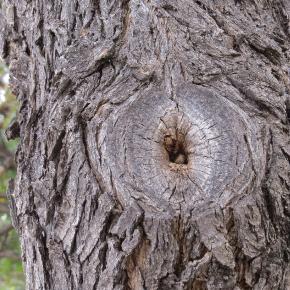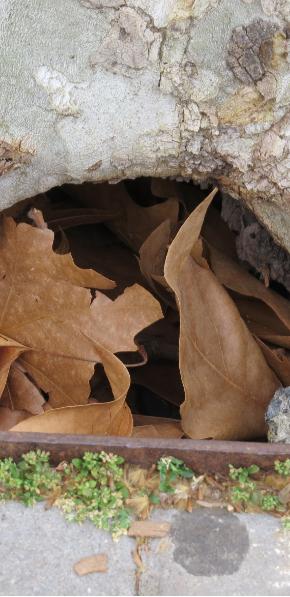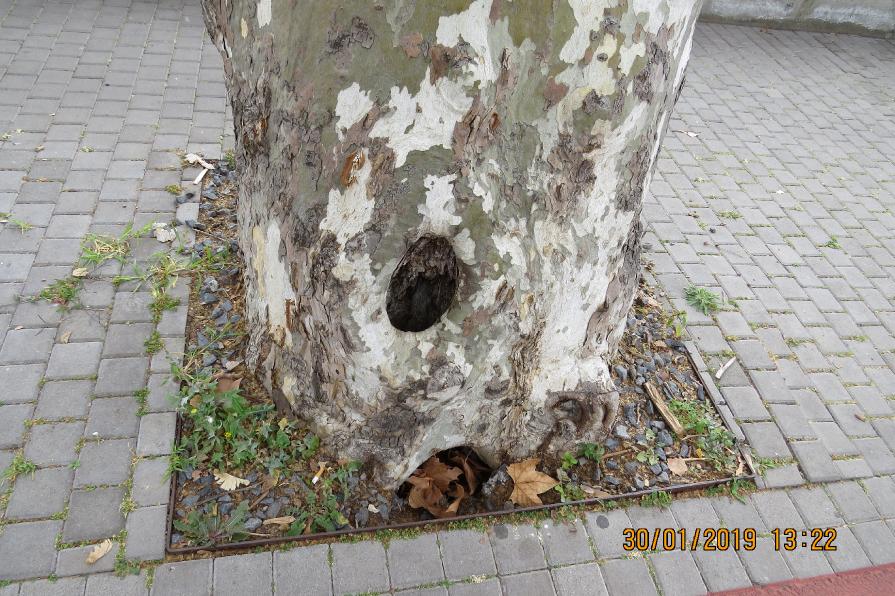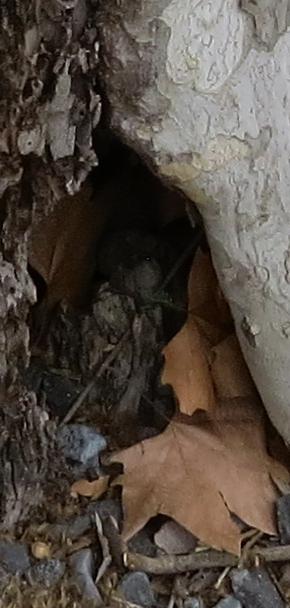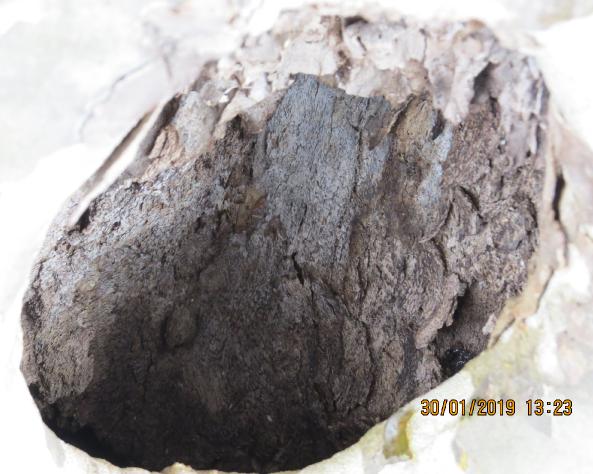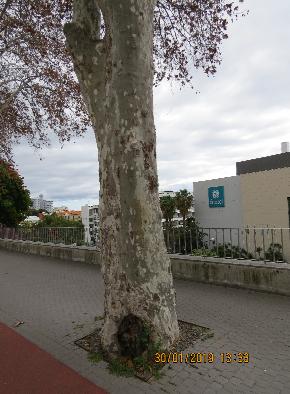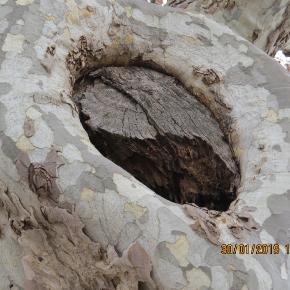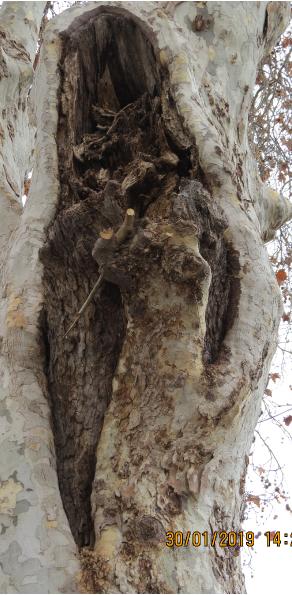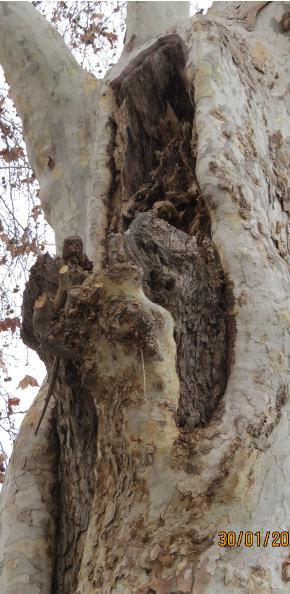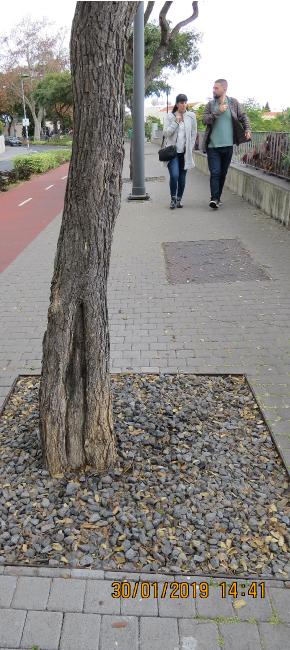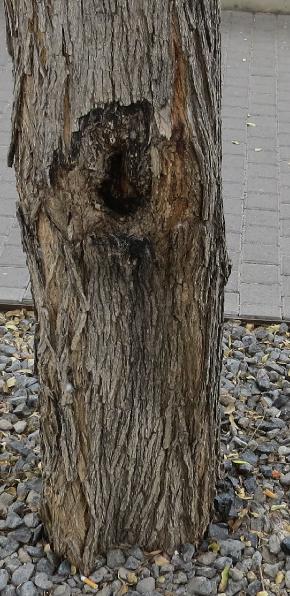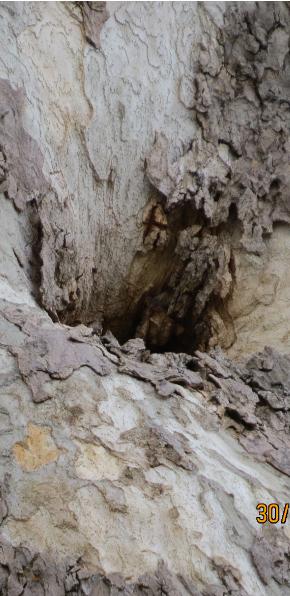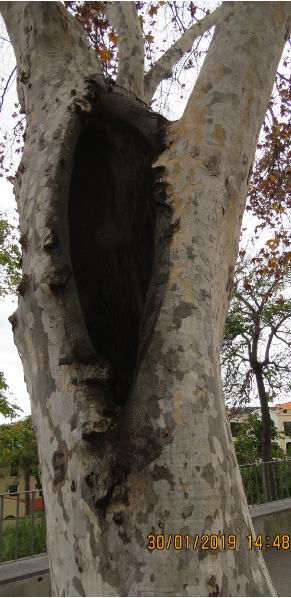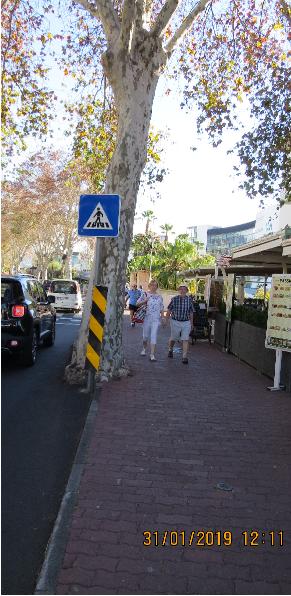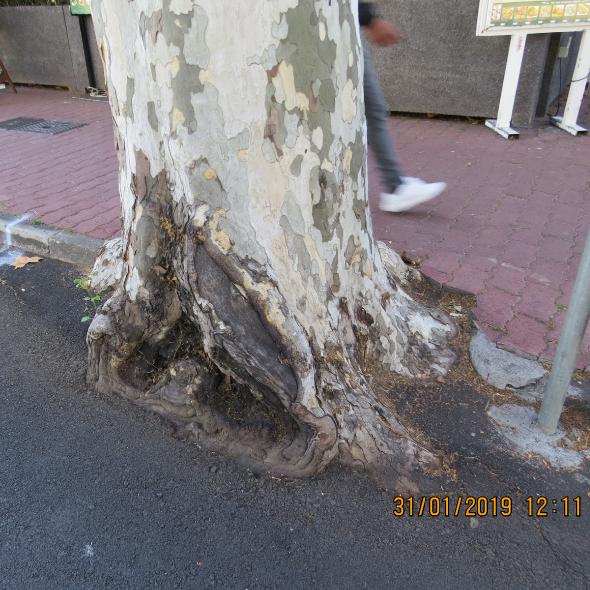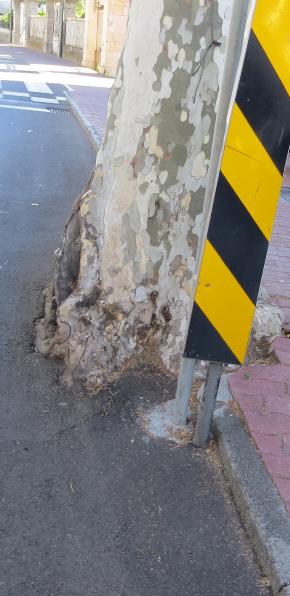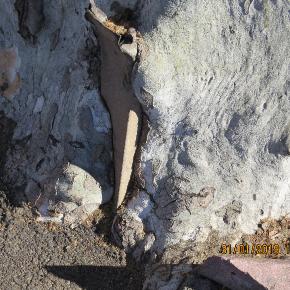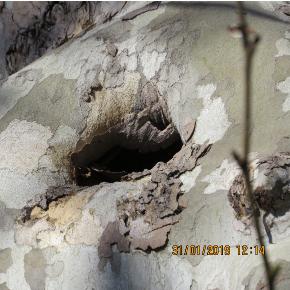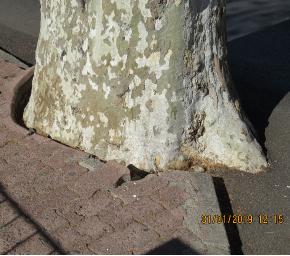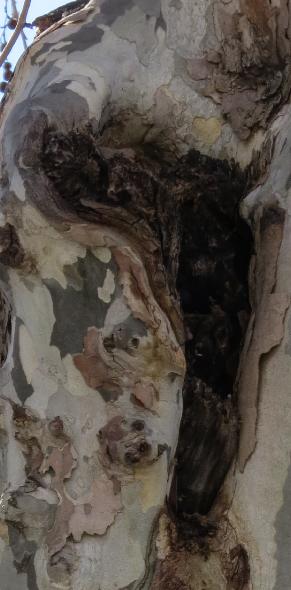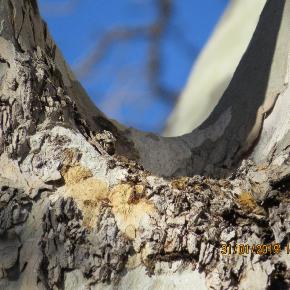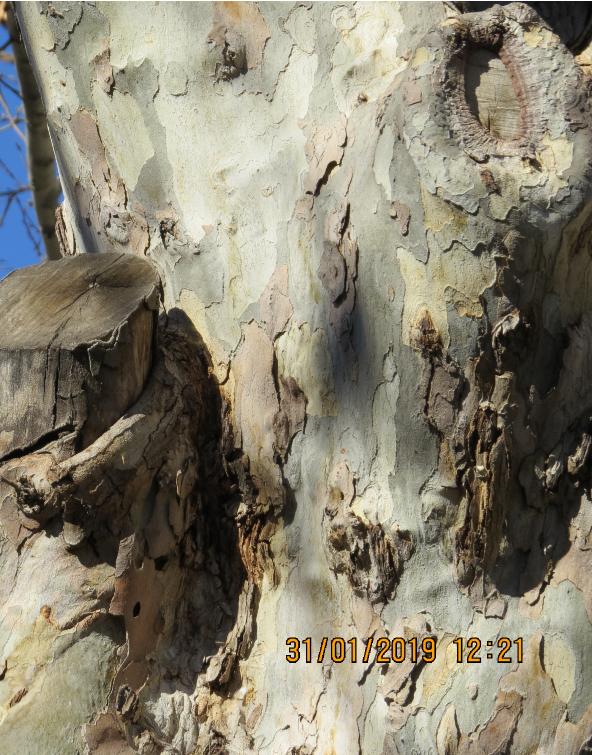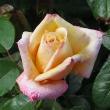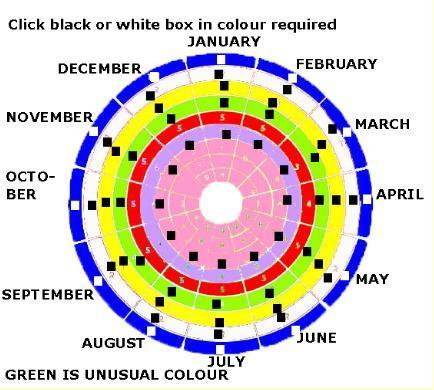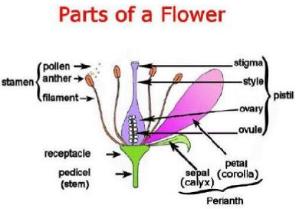Ivydene Gardens Home: |
READING THE TEXT IN RED ON THIS PAGE WILL MAKE IT EASIER FOR YOU TO USE EACH PAGE in my educational website.
THE 2 EUREKA EFFECT PAGES FOR UNDERSTANDING SOIL AND HOW PLANTS INTERACT WITH IT OUT OF 10,000:-
Explanation of Structure of this Website with User Guidelines Page for those photo galleries with Photos (of either ones I have taken myself or others which have been loaned only for use on this website from external sources) |
HOME PAGES Welcome - Ivydene Gardens informs you how to design, construct and maintain your private garden using organic methods and companion planting. Sub Menu to each Page of this Topic of the HOME PAGES, with normally a * after Page you are viewing.
Damage to Tree Trunks 1, 2, 3, 4 caused by people, Camera Photo Galleries:- Will visitors to Madeira worry about having branches or trees in public places fall on them? No; according to Engineer Francisco Pedro Freitas Andrade of Est. Marmeleiros, No 1, Jardins & Espaces Verdes who is Chef de Diviso Câmara Municipal do Funchal; Departamento de Ciência e de Recursos Naturais; Divisão de Jardins e Espaços Verdes Urbanos in charge of the trees within the pavements within the area controlled by Funchal Municipality - See Monitoring of Trees in pavements in Funchal, Madeira from September 2019 to February 2010 1, 2 pages by his department. PROBLEMS WITH TREES IN PAVEMENTS IN ST. PETER PORT, GUERNSEY IN SEPTEMBER 2019 |
|
|
|
|
|
|
|
|
|
Photo 34a - tree 14 forum end of 2 road junction IMG_6174.JPG This cut end has dried, cracked and the rot has started in the centre. The size of the hole will accelerate as it becomes wet and this provides transportation for the airborne pests and the ones that have already landed to further unrotted areas. Photo 35 - tree 15 forum end of 2 road junction IMG_6186.JPG Further rot from the centre on another tree. Photo 36 - tree 16 forum end of 2 road junction IMG_6189.JPG This looks like quite a deep hole inside this trunk of tree 16 doesn't it? Photo 37 - tree 16 forum end of 2 road junction IMG_6188.JPG |
|
|
|
Photo 38 - tree 16 forum end of 2 road junction trunk badly damaged IMG_6190.JPG If Photo 37 truly shows another hole in the trunk of the same tree as in Photos 36 and this one, that means 3 deep holes in 1 tree, which the Funchal maintenance staff have missed. This would mean that this tree is a very great danger to the environment. |
|
||
Photo 39 - tree 19 forum end of 2 road junction IMG_6197.JPG Detail of right hand side of hole at the bottom indicates dead leaves by the entrance and half-way up on the left is another leaf set further back in the hole. This indicates that more than 30% of this tree trunk has rotted at ground level. But do not worry, just use your stiff upper lip and ignore it. A larger picture of this tree appears in the next row. Photo 40 - tree 17 forum end of 2 road junction IMG_6192.JPG This size of hole caused by rot indicates that this other tree trunk is seriously weakened. |
|
|
|
Photo 41 - tree 19 forum end of 2 road junction IMG_6197.JPG This the larger picture of the tree with serious rot in it's trunk - below it is |
|
||
There's always one. This has got to be one of the funniest things in a long time and this guy should have been promoted, not fired. This is a true story from the Word Perfect Helpline, which was transcribed from a recording monitoring the customer care department. Needless to say the Help Desk employee was fired; however, they are currently suing the Word Perfect organization for 'Termination without Cause'. Actual dialogue of a former WordPerfect Customer Support employee. (Now you know why they record these conversations!):
Operator: 'Ridge Hall, computer assistance; may I help you?' Caller: 'Yes, well, I'm having trouble with WordPerfect.' Operator: 'What sort of trouble??' Caller: 'Well, I was just typing along, and all of a sudden the words went away.' Operator: 'Went away?' Caller: 'They disappeared.' Operator: 'Hmm So what does your screen look like now?' Caller: 'Nothing.' Operator: 'Nothing??' Caller: 'It's blank; it won't accept anything when I type.' Operator: 'Are you still in WordPerfect, or did you get out??' Caller: 'How do I tell?' Operator: 'Can you see the C: prompt on the screen??' Caller: 'What's a sea-prompt?' Operator: 'Never mind, can you move your cursor around the screen?' Caller: 'There isn't any cursor: I told you, it won't accept anything I type.' Operator: 'Does your monitor have a power indicator??' Caller: 'What's a monitor?' Operator: 'It's the thing with the screen on it that looks like a TV. Does it have a little light that tells you when it's on??' Caller: 'I don't know.' Operator: 'Well, then look on the back of the monitor and find where the power cord goes into it. Can you see that??' Caller: 'Yes, I think so.' Operator: 'Great. Follow the cord to the plug, and tell me if it's plugged into the wall. Caller: 'Yes, it is.' Operator: 'When you were behind the monitor, did you notice that there were two cables plugged into the back of it, not just one??' Caller: 'No.' Operator: 'Well, there are. I need you to look back there again and find the other cable.' Caller: 'Okay, here it is.' Operator: 'Follow it for me, and tell me if it's plugged securely into the back of your computer.' Caller: 'I can't reach.' Operator: 'Uh huh. Well, can you see if it is??' Caller: 'No.' Operator: 'Even if you maybe put your knee on something and lean way over??' Caller: 'Oh, it's not because I don't have the right angle - it's because it's dark.' Operator: 'Dark??' Caller: 'Yes - the office light is off, and the only light I have is coming in from the window. ' Operator: 'Well, turn on the office light then.' Caller: 'I can't.' Operator: 'No? Why not??' Caller: 'Because there's a power failure.' Operator: 'A power........ A power failure? Aha, Okay, we've got it licked now. Do you still have the boxes and manuals and packing stuff your computer came in??' Caller: 'Well, yes, I keep them in the closet.' Operator: 'Good. Go get them, and unplug your system and pack it up just like it was when you got it. Then take it back to the store you bought it from.' Caller: 'Really? Is it that bad?' Operator: 'Yes, I'm afraid it is.' Caller: 'Well, all right then, I suppose. What do I tell them??' Operator: 'Tell them you're too bloody stupid to own a computer ...' |
|||
Photo 42 - tree 20 forum end of 2 road junction IMG_6200.JPG The exposed heartwood is drying out and cracking. The thin vertical black section to the roght of this crack has rotted through the bark, but it is unknown how much further into the trunk what further damage has been done. Photo 43 - tree 22 from end of 2 road junction IMG_6210.JPG The exposed heartwood has dried, cracked and started to rot. Photo 44 - tree 22 from end of 2 road junction IMG_6211.JPG The exposed heartwood has dried, cracked and started to rot. Photo 45 - tree 22 from end of 2 road junction IMG_6214.JPG The 2 trunks at the top of the photo is a tree fork which could grow and press against each other and 1 will dominate. When it does the single trunk below will be split by the pressure and then rot before the whole tree falls down. |
|
|
|
Photo 46 - tree 22 from end of 2 road junction IMG_6212.JPG If this trunk with this size hole was cut out from the tree fork this would benefit the tree. Unfortunately we cannot see if the heartwood has rotted down to join the single trunk from which this left hand trunk occured as part of the tree fork. If it has, then still cut it off and see if there is sufficient trunk left in the main single trunk to save the remainder of this tree with its 2 bits of damage to the trunks and to suffer the weakness at the tree fork in the trunk from being part of a tree fork. I hope it can be repaired, but this tree does present problems that urgently need attention. Another tree to disturb the owners of the Enotel Hotel below it. Depending on the tree; tree fork can cause weakness in the tree for both trunks which join at the fork. If this is seen in a tree before it is planted, it would be wise to cut out 1 of the trunks, once planted. WHY DO I TRY AND SAVE THESE TREES? THEY PRODUCE PART OF THE OXYGEN THAT I BREATHE, SO THAT I CAN REMAIN ALIVE. |
|
||
Photo 47 - tree 23 from end of 2 road junction IMG_6215.JPG Heartwood is dry, cracking and starting to rot, with deeper sections of rot where the rotted heartwood is black. Photo 48 - tree 23 from end of 2 road junction IMG_6216.JPG Almost half the exposed surface of heartwood has further rotted into the trunk. How far? Photo 49 - tree 23 from end of 2 road junction IMG_6217.JPG I wonder if there had been a third branch/trunk which had ripped off and the resulting exposed heartwood is rotting this tree fork. |
|
|
|
Photo 50 - tree 23 from end of 2 road junction IMG_6218.JPG The exposed heartwood is rotting. I wonder if the Enotel Hotel has any wood fires. Drastic pollarding down to non-rotten of a few trees in the pavement of the road above them could be used for one of the reasons that one pollards a tree - firewood. Photo 50a - tree 26 from end of 2 road junction IMG_6230.JPG Badly pruned branch, which has not been sealed with black masonry paint or Arbrex. The branch was cut from above down to just above the bottom, and then ripped off leaving a small bottom area of jagged heartwood and the bark ripped off back to the branch from which the branch had been cut. The cut to the main cut branch also cut through a secondary branch in the direction of the secondary branch. This revealed the area within the heartwood of the branch that cut off of where that valid branch not a watersprout had grown from and its large area of the join between the 2 branches rather than the miniscule area of a watersprout to a cut stump in a small section of the circumference of the stump end. Photo 51 - tree 25 from end of 2 road junction IMG_6227.JPG Rot from area of ripped off branch. Photo 52 - tree 25 from end of 2 road junction IMG_6228.JPG Same tree as above with side view. |
|
|
|
Photo 53 - tree 27 from end of 2 road junction IMG_6236.JPG This branch was undercut and then cut from the left hand side. The pruner could not wait to cut through the rest of the branch, so it was simply snapped off. Luckily this did not damage the trunk. The cut should have been further out for the undercut, so that the cut from above would start about 0.5 inch (1 cm) further along the branch at the top, so that when it came close to the horizontal distance with the level of the undercut, the branch would break off. Then the stump could be cut through again to make a single cut end, before it was then sealed. This cutting procedure reduces the risk of the branch being cut from breaking off and tearing off bark and part of the trunk when that branch can no longer support itself and its weight falling then will do that damage. Photo 54 - tree 27 from end of 2 road junction IMG_6237.JPG Heartwood drying and cracking. Photo 55 - tree 29 from end of 2 road junction IMG_6250.JPG This hole shows rotted part of the inside heartwood of this tree. Photo 56 - tree 31 from end of 2 road junction IMG_6258.JPG The exposed heartwood has dried and is now cracking in preparation for being eaten. |
|
|
|
Photo 57 - tree 30 from end of 2 road junction IMG_6256.JPG The black section of the exposed heartwood is rotting. Photo 58 - tree 32 from end of 2 road junction road section to lido IMG_6263.JPG The exposed heartwood is starting to rot and the tree is grateful for the pavers on its roots. Photo 59 - tree 32 from end of 2 road junction with watersprout and proper branch IMG_6260.JPG 2 branch stumps starting to rot. Photo 60 - tree 34 from end of 2 road junction IMG_6266.JPG A deep rotten heartwood hole. |
|
|
|
Photo 61 - tree 34 from end of 2 road junction IMG_6269.JPG A big hole at a tree fork which has been covered with metal mesh and then ignored. Photo 62 - tree 34 from end of 2 road junction with black plastic mesh IMG_6271.JPG It is a very large hole in the trunk at a very much weaker point in a tree fork. If it splits when the 2 trunks fall down, hopefully the people drinking their coffee in the raised section opposite the cafe building and overhanging the public garden below may not be affected. This is assuming that no repair job is urgently carried out to prevent several tons of tree falling onto the main road below. No pressure. This is the problem with being a pesky foreigner, one needs to explain oneself better so that there can be as little misunderstanding as possible in translating english English to another country's English. |
|
|
|
Photo 63 - tree 45 from pestana promenade by lido taxi rank IMG_6309.JPG The exposed heartwood has started rotting. Photo 64 - tree 45 from pestana promenade by lido taxi rank IMG_6307.JPG Has the rot in the top trunk hole reached the bottom hole? Photo 65 - tree 46 from pestana promenade past lido out in road IMG_6310.JPG The bottom of this trunk of this tree is mostly in the road. Photos below show what happens. |
|
|
|
Photo 66 - tree 46 from pestana promenade past lido IMG_6311.JPG This tree has been repeatedly hit by the traffic. Add insult to injury, tarmac surrounds one side and concrete pavers the other. Photo 67 - tree 46 from pestana promenade past lido IMG_6312.JPG Which is not surprising when it is this far out into the road. Why not put the signs out beyond the tree, since nobody seems to take any notice of the yellow/black one? Perhaps a sign stating "Killing Trees using Vehicles Endurance Road - Warning Please look under your vehicles for penguins. Sponsored by Cover Land with Concrete Association" instead of the Yellow/Black sign might be more effective. |
|
|
|
Photo 68 - tree 47 from pestana promenade past lido out in road IMG_6315.JPG This was a metal post supporting a sign. The tree has grown round it. Photo 69 - tree 47 from pestana promenade past lido out in road IMG_6316.JPG Rotting of the heartwood in this trunk in these 2 places of the same tree. Photo 70 - tree 47 from pestana promenade past lido out in road IMG_6314.JPG More than half the tree trunk at road level is out in the road. Normally native drivers in Madeira are loth to run over organisms like people crossing the road. The trouble is these trees are moving so slowly that they are not prepared to wait. |
|
|
|
Photo 71 - tree 48 from pestana promenade past lido out in road IMG_6318.JPG This tree is in the road. Photo 72 - tree 49 from pestana promenade past lido out in road IMG_6321.JPG This tree is in the road. Photo 73 - tree 49 from pestana promenade past lido out in road IMG_6320.JPG This is the same tree as above, but the other side. There is a deep hole in this side within the heartwood under the trunk. Photo 74 - tree 49 from pestana promenade past lido out in road IMG_6322.JPG This is the same tree with a deep hole in the heartwood further up the trunk. |
|
|
|
Photo 75 - tree 50 from pestana promenade past lido out in road IMG_6324.JPG Another tree in the road with the following 4 photos of rot in its trunk. and Photo 80 indicates which tree. Photo 76 - tree 50 from pestana promenade past lido out in road IMG_6327.JPG Photo 77 - tree 50 from pestana promenade past lido out in road IMG_6328.JPG Photo 78 - tree 50 from pestana promenade past lido out in road IMG_6329.JPG |
|
|
|
Photo 79 - tree 50 from pestana promenade past lido out in road IMG_6325.JPG Photo 80 - tree 50 from pestana promenade past lido out in road IMG_6325.JPG
Photo 81 - tree 51 from pestana promenade past lido out in road IMG_6330.JPG Another tree in the road with one hole rotting and maybe the start of another in the junction between trunks as shown in the following 2 photos. |
|
|
|
Photo 82 - tree 51 from pestana promenade past lido out in road IMG_6331.JPG Exposed Heartwood has been rotting for some time. How far? Photo 83 - tree 51 from pestana promenade past lido out in road IMG_6332.JPG It is possible that the indentation between these 2 trunks may have been damaged and rotted, since this area of exposed bark is different to that of the rest, when perhaps it should be the same as can be seen on the other side of the depression. Of course as an untrained amateur, who has cut down a mature birch tree, who am I to tell the experts anything? Each section when cut had to be suspended in the air using ropes - one to hold it up and the other to guide its descent, otherwise the corrugated asbestos roof on the pub building alongside, the mature evergreen shrubs on either side with the standard roses in front of the 200 cm x 100 cm (80 x 40 inches) clear section of ground could have been damaged. I took a week to cut it down, cut it up and remove it in a wheelbarrow through the walkway to the street in the front by myself for my elderly infirm client in his terraced house with its neighbouring terrace houses. You never know but if the experts will see the photos, they might form their own conclusions.
Photo 84 - tree 52 from pestana promenade past lido out in road IMG_6335.JPG These 2 areas of exposed heartwood could be painted to prevent further rotting of this tree which is only slightly in the road as shown in the following 2 photos. |
|
|
|
Photo 85 - tree 52 from pestana promenade past lido out in road IMG_6333.JPG Photo 86 - tree 52 from pestana promenade past lido out in road IMG_6334.JPG
Photo 87 - tree 53 from pestana promenade past lido out in road with root access to water IMG_6336.JPG This tree has pushed the kerb out of line and decided to fall in love with a road drain. We do not know if they still courting or whether they are joined in matrimony. I suspect that they have consented, but unfortunately a marriage between a tree and a piece of metal is unlikely to produce baby drains. |
|
|
|
This website is being created by Chris Garnons-Williams of Ivydene Horticultural Services from it's start in 2005. I am requesting free colour photographs of any plants grown in or sold in the United Kingdom to add to the plants in the Plant Photographic Galleries and Butterfly photographs for the Butterfly on Plant Photographic Galleries. |
Site design and content copyright ©April 2007. Page structure amended October 2012. Page structure changed February 2019 for pages concerning Trees in pavements alongside roads in Madeira. Chris Garnons-Williams. DISCLAIMER: Links to external sites are provided as a courtesy to visitors. Ivydene Horticultural Services are not responsible for the content and/or quality of external web sites linked from this site. |
It should be remembered that nothing is sold from this educational site, it simply tries to give you the best advice on what to use and where to get it (About Chris Garnons-Williams page details that no payment or commision to or from any donor of photos or adverts I place on the site in the Useful Data or other sections is made to Chris Garnons-Williams or Ivydene Horticultural Services). This website is a hobby and not for direct commercial gain for Ivydene Horticultural Services. There is no Google Adscenes or Search Facility in this website. The information on this site is usually Verdana 14pt text (from December 2023, this is being changed from 14pt to 10pt) and all is in tabular form. This can be downloaded and sorted using WORD or other word-processing software into the order that you personally require, especially for soil subsidence, the Companion Planting Tables and the pages in the Plants section. This would be suitable for use in education as well. I put jokes in at various places to give you a smile. |
|
At long last, this shows that another new service is being trialled in Madeira. Rather than offloading the passengers from the Cruise Liners, Madeira is trialling the idea of delivering the Cruise Liner to the museum, restaurant, gambling casino or history tellers tour venue that more than 20 passengers wish to visit on the land to minimise the exercise required by those passengers. They will then be picked up after they have enjoyed their time at the relevant venue before the liner is put back into its pond (some people call it an Ocean, others simply say we will see you across the pond in referring to people moving from Europe to America, with pond instead of Ocean)
|
|||
The following is from "Some time around 600 million years ago, green algae began to move out of shallow fresh waters and onto the land. They were the ancestors of all land plants... Today, plants make up to 80% of the mass of all life on Earth and are the base of the food chains that support nearly all terrestrial organisms.... But the algal ancestors of land plants had no roots, no way to store or transport water, and no experience in extracting nutrients from solid ground. How did they manage the fraught passage onto dry land? ... It was only by striking up new relationships with fungi that algae were able to make it onto land. These early alliances evolved into what we now call mycorrhizal relationships. Today, more than 90% of all plant species depend on mycorrhizal fungi. Mycorrhizal associations are the rule not the exception: a more fundamental part of planthood than fruit, flowers, leaves, wood or even roots.... For the relationship to thrive, both plant and fungus must make a good metabolic match. In photosynthesis, plants harvest carbon from the atmosphere and forge the energy-rich carbon compounds - sugars and lipids - on which much of the rest of life depends. By growing within plant roots, mycorrhizal fungi acquire privileged access to these sources of energy: they get fed. However, photosynthesis is not enough to support life. Plants and fungi need more than a source of energy. Water and minerals must be scavenged from the ground - full of textures and micropores, electrically charged cavities and labyrinthine rot-scapes. Fungi are deft rangers in this wilderness and can forage in a way that plants can not. By hosting fungi within their roots, plants gain hugely improved access to these sources of nutrients. They, too, get fed. By partnering, plants gain a prosthetic fungus, and fungi gain a prosthetic plant. Both use the other to extend their reach.... By the time the first roots evolved, the mycorrhizal association was already some 50 million years old. Mycorrhizal fungi are the roots of all subsequent life on land. Today, hundreds of millions of years later, plants have evolved, faster-growing, opportunistic roots that behave more like fungi. But even these roots cannot out-manoeuvre fungi when it comes to exploring the soil. Mycorrhizal hyphae are 50 times finer than the finest roots and can exceeed the length of a plant's roots by as much as a 100 times. Their mycelium makes up between a third and a half of the living mass of soils. The numbers are astronomical. Globally, the total length of mycorrhizal hyphae in the top 10 centimetres (4 inches) of soil is around half the width of our galaxy (4.5 x 10 to the power 17 kilometres versus 9.5 x 10 to the power 17 kilometres). If these hyphae were ironed into a flat sheet, their combined surface area would cover every inch of dry land on Earth 2.5 times over.... In their relationship, plants and mycorrhizal fungi enact a polarity: plant shoots engage with the light and air, while the fungi and plant roots engage with the solid ground. Plants pack up light and carbon dioxide into sugars and lipids. Mycorrhizal fungi unpack nutrients bound up in rock and decomposing material. These are fungi with a dual niche: part of their life happens within the plant, part in the soil. They are stationed at the entry point of carbon into terrestrial life cycles and stitch the atmosphere into relation with the ground. To this day, mycorrhizal fungi help plants cope with drought, heat and many other stresses life on land has presented from the very beginning, as do the symbiotic fungi that crowd into plant leaves and stems. What we call 'plants' are in fact fungi that have evolved to farm algae, and algae that have evolved to farm fungi.... Mycorrhizal fungi can provide up to 80% of a plant's nitrogen, and as much as 100% of its phosphorus. Fungi supply other crucial nutrients to plants, such as zinc and copper. They also supply plants with water, and help them to survive drought as they have done since the earliest days of life on land. In return, plants allocate up to 30% of the carbon they harvest to their mycorrhizal partners.... And yet mycorrhizal fungi do more than feed plants. Some describe them as keystone organisms; others prefer the term 'ecosystem engineers'. Mycorrhizal mycelium is a sticky living seam that holds soil together; remove the fungi, and the ground washes away. Mycorrhizal fungi increase the volume of water that the soil can absorb, reducing the quantity of nutrients leached out of the soil by rainfall by as much as 50%. Of the carbon that is found in soils - which, remarkably, amounts to twice the amount of carbon found in plants and the atmosphere combined - a substantial proportion is bound up in tough organic compounds produced by mycorrhizal fungi. The carbon that floods into the soil through mycorrhizal channels supports intricate food webs. Besides the hundreds or thousands of metres of fungal mycelium in a teaspoon of healthy soil, there are more bacteria, protists, insects and arthropods than the number of humans who have ever lived on Earth. Mycorrhizal fungi can increase the quality of a harvest. They can also increase the ability of crops to compete with weeds and enhance their resistance to diseases by priming plant's immune systems. They can make crops less susceptible to drought and heat, and more resistant to salinity and heavy metals. They even boost the ability of plants to fight off attacks from insect pests by stimulating the production of defensive chemicals... But over the course of the twentieth century, our neglect has led us into trouble. In viewing soils as more or less lifeless places, industrial agricultural practices have ravaged the undergound communities that sustain the life we eat.... A large study published in 2018 suggested that the 'alarming deterioration' of the health of trees across Europe was caused by a disruption of their mycorrhizal relationships, brought about by nitrogen pollution." from Before Roots chapter by Merlin Sheldrake.
"We do know, that this fragile, generative world has been damaged by intensive farming, pollution, deforestation and global heating. A third of the planet's land has been severely degraded and 24 billion tons of fertile soil are destroyed every year through intensive farming, according to the Global Land Outlook. Topsoil is where 95% of the planet's food is grown and is very delicate. It takes more than 100 years to build 5mm of soil, and it can be destroyed shockingly easily. This destruction and degradation of the soil is created by intensive farming practices such as heavy mechanised soil tilling, which loosens and rips away any plant cover, leaving the soil bare. It is also caused by the overgrazing of animals, as well as forest fires and heavy construction work. These factors disturb the soil and leave it exposed to erosion from wind and water, damaging the complicated systems underneath its top layer... We are losing good soil at an estimated 100 times faster rate than we can remake and heal it. The world's soils are thought to store approximately 15 thousand million tonnes of carbon - 3 times as much as all of our planet's terrestrial vegetation combined. Soils hold twice as much carbon as the atmosphere, and when soil disintegrates, the carbon is released. In the last 40 years the soil in the UK's croplands lost 10% of the carbon it could store. In a time of climate crisis, soil's quiet potency, its ability to store carbon safely, is utterly essential to our future survival.... We know that soils are being destroyed, and that with that comes a higher risk of floods, and a more unpredictable and unreliable food and water system. An Intergovernmental Science-Policy Platform on Biodiversity and Ecostem Services report in 2018 told us clearly that land degradationis already putting the welfare of two-fifths of humanity at risk, and that urgent action is needed to avoid further danger. There are many things we can do to protect soils, and the organisms, plants and connections that thrive within them. Actions that can support and heal soil structure include
Such regimes allow soil structure to remain intact, and protect the soil by allowing crop residues to stay on the surface. " from Strange Soil chapter by Rebecca Tamas. |
Due to intensive farming techniques and chemical fertilisers this has occurred:- The BBC has produced an article as to why modern food as lost its nutrients. |
The following about trees in pavements show why when the roots are denied access to air, water and nutrients even the fungi cannot work to support the trees. Pavements of Funchal, Madeira |
The following addition of this mulch improved the clay soil, so that A 150mm deep mulch of mixed peat, sharp washed sand and horticultural grit was applied on top of a heavy clay soil to improve its structure, and stop the plants therein from drowning, at £10 a square metre. The mix was:
The following was then sent to me:-
and the following was sent to me in October 2004:- An unsuccessful planting scheme had left bare areas of garden as plants failed to survive winter in the waterlogged clay soil. The loss of numerous plants and the cost of replacing them had left us disheartened. It was evident that remedial action was need in the form of a mixture of gravel, sand and peat to create an organic loam. Approximately six inches was added in April and left to settle and do its job. By July there was a noticeable difference in the quality of the soil and the plants. Shrubs with sparse, mottled leaves were looking glossy and robust, overall growth had increased (including the weeds!) and the soil was holding its moisture well. But the biggest difference came in the confidence it gave us to transform the garden. The borders used to be a no-go area between May and September as the clay baked and cracked, but the new soil was easy to handle and weeds could be successfully removed. We realised that there are no quick fixes - the key to a healthy garden is rich, nutritous soil. Once our plants began to thrive we were optimistic that, with good advice, we could create a garden to be proud of. |
More Details |
Cultural Needs of Plants "Understanding Fern Needs |
|
It is worth remembering that especially with roses that the colour of the petals of the flower may change - The following photos are of Rosa 'Lincolnshire Poacher' which I took on the same day in R.V. Roger's Nursery Field:- |
|
Closed Bud |
|
Opening Bud |
|
Juvenile Flower |
|
Older Juvenile Flower |
|
Middle-aged Flower - Flower Colour in Season in its |
|
Mature Flower |
|
Juvenile Flower and Dying Flower |
|
Form of Rose Bush |
There are 720 roses in the Rose Galleries; many of which have the above series of pictures in their respective Rose Description Page. So one might avoid the disappointment that the 2 elephants had when their trunks were entwined instead of them each carrying their trunk using their own trunk, and your disappointment of buying a rose to discover that the colour you bought it for is only the case when it has its juvenile flowers; if you look at all the photos of the roses in the respective Rose Description Page!!!! |
|
There are 180 families in the Wildflowers of the UK and they have been split up into 22 Galleries to allow space for up to 100 plants per gallery. Each plant named in each of the Wildflower Family Pages may have a link to:- its Plant Description Page in its Common Name in one of those Wildflower Plant Galleries and it does have links:- to external sites to purchase the plant or seed in its Botanical Name, to see photos in its Flowering Months and to read habitat details in its Habitat Column. |
|
Links to external websites like the link to "the Man walking in front of car to warn pedestrians of a horseless vehicle approaching" would be correct when I inserted it after March 2007, but it is possible that those horseless vehicles may now exceed the walking pace of that man and thus that link will currently be br My advice is Google the name on the link and see if you can find the new link. If you sent me an email after clicking Ivydene Horticultural Services text under the Worm Logo on any page, then; as the first after March 2010 you would be the third emailer since 2007, I could then change that link in that 1 of the 15,743 pages. Currently (August 2016). Other websites provide you with cookies - I am sorry but I am too poor to afford them. If I save the pennies from my pension for the next visitor, I am almost certain in March 2023, that I could afford to make that 4th visitor to this website a Never Fail Cake. I would then be able to save for more years for the postage. |
UKButterflies Larval Foodplants website page lists the larval foodplants used by British butterflies. The name of each foodplant links to a Google search. An indication of whether the foodplant is a primary or secondary food source is also given. Please note that the Butterfly you see for only a short time has grown up on plants as an egg, caterpillar and chrysalis for up to 11 months, before becoming a butterfly. If the plants that they live on during that time are removed, or sprayed with herbicide, then you will not see the butterfly. |
||||
Plants used by the Butterflies follow the Plants used by the Egg, Caterpillar and Chrysalis as stated in |
||||
Plant Name |
Butterfly Name |
Egg/ Caterpillar/ Chrysalis/ Butterfly |
Plant Usage |
Plant Usage Months |
Egg, |
1 egg under leaf. |
10 days in May-June |
||
Egg, |
Eggs laid in batches encircling the branch of the food plant. |
Hatches after 18-22 days in April. |
||
Egg, |
Groups of eggs on upper side of leaf. |
- |
||
Egg, |
1 egg at base of plant. |
Late August-April |
||
Egg, |
Groups of eggs on upper side of leaf. |
- |
||
Egg, |
1 egg laid on underside of leaflets or bracts. |
7 days in June. |
||
Egg, |
1 egg laid on underside of leaflets or bracts. |
7 days in June. |
||
Egg, |
1 egg laid under the leaf or on top of the flower. |
7 days in August. |
||
Egg, |
1 egg on underside of a flower bud on its stalk. |
7 days. |
||
Egg, |
1 egg on underside of a flower bud on its stalk. |
7 days. |
||
Egg, |
1 egg under leaf. |
10 days in May-June. |
||
Egg, |
1 egg on leaf. |
2 weeks |
||
Cabbages - Large White eats all cruciferous plants, such as cabbages, mustard, turnips, radishes, cresses, nasturtiums, wild mignonette and dyer's weed |
Egg,
|
40-100 eggs on both surfaces of leaf. |
May-June and August-Early September. 4.5-17 days. |
|
Egg, |
1 egg on underside of leaf. |
May-June and August. 7 days. |
||
Cabbages:- |
Egg, |
1 egg on underside of leaf. |
July or August; hatches in 3 days. |
|
Cabbages:- |
Egg, |
1 egg laid in the tight buds and flowers. |
May-June 7 days. |
|
Cherry with |
Egg, |
Eggs laid in batches encircling the branch of the food plant. |
Hatches after 18-22 days in April. |
|
Egg, |
Groups of eggs on upper side of leaf. |
- |
||
Egg, |
1 egg on leaf. |
10 days in May-June. |
||
Egg, |
1 egg on leaf. |
6 days in May-June. |
||
Egg, |
1 egg under leaf. |
|
||
|
(Common CowWheat, Field CowWheat) |
Egg, |
Eggs laid in batches on the under side of the leaves. |
Hatches after 16 days in June. |
|
Currants |
Egg, |
Groups of eggs on upper side of leaf. |
|
|
Egg, |
Eggs laid in batches on the under side of the leaves. |
Hatches after 20 days in July. |
||
Dog Violet with |
Egg, |
1 egg on oak or pine tree trunk |
15 days in July. |
|
Dog Violet with |
Egg, |
1 egg on leaf or stem. |
Hatches after 15 days in May-June. |
|
Dog Violet with |
Egg, |
1 egg on leaf or stem. |
Hatches after 10 days in May-June. |
|
Egg, |
1 egg on underside of a flower bud on its stalk. |
7 days. |
||
Egg, |
Eggs laid in batches encircling the branch of the food plant. |
Hatches after 18-22 days in April. |
||
False Brome is a grass (Wood Brome, Wood False-brome and Slender False-brome) |
Egg, |
1 egg under leaf. |
... |
|
Egg, |
Eggs laid in batches on the under side of the leaves. |
Hatches after 20 days in July. |
||
Egg, |
1 egg laid on underside of leaflets or bracts. |
7 days in June. |
||
Egg, |
1 egg on leaf or stem. |
Hatches after 10 days in May-June. |
||
Egg, |
1 egg on underside of a flower bud on its stalk. |
7 days. |
||
Egg, |
1 egg laid under the leaf or on top of the flower. |
7 days in August. |
||
Egg, |
1 egg on leaf. 5 or 6 eggs may be deposited by separate females on one leaf. |
14 days in July-August. |
||
Egg, |
1 egg on underside of a flower bud on its stalk. |
7 days. |
||
Egg, |
1 egg laid in the tight buds and flowers. |
May-June 7 days. |
||
Egg, |
Eggs laid in batches on the under side of the leaves. |
Hatches after 20 days in July. |
||
Egg, |
Groups of eggs on upper side of leaf. |
|
||
Egg, |
1 egg under leaf. |
1 then |
||
Egg, |
1 egg on underside of a flower bud on its stalk. |
7 days. |
||
Egg, |
1 egg at base of plant. |
Late August-April. |
||
Egg, |
1 egg on leaf. |
10 days in May-June. |
||
Egg, |
1 egg on leaf. |
2 weeks |
||
Egg, |
1 egg on leaf. |
6 days in May-June. |
||
Egg, |
1 egg on underside of leaf. |
May-June and August. 7 days. |
||
Egg, |
1 egg on leaf. 5 or 6 eggs may be deposited by separate females on one leaf. |
14 days in July-August. |
||
Narrow-leaved Plantain (Ribwort Plantain) |
Egg, |
Eggs laid in batches on the under side of the leaves. |
Hatches after 16 days in June. |
|
Narrow-leaved Plantain (Ribwort Plantain) |
Egg, |
Eggs laid in batches on the under side of the leaves. |
Hatches after 16 days in June. |
|
Nasturtium from Gardens |
Egg, |
1 egg on underside of leaf. |
May-June and August. 7 days. |
|
Egg, |
1 egg on tree trunk |
15 days in July. |
||
Mountain pansy, |
Egg, Chrysalis |
1 egg laid under the leaf or on top of the flower. |
7 days in August. 3 weeks in September |
|
Egg, |
1 egg on tree trunk. |
15 days in July. |
||
Egg, |
Eggs laid in batches on the under side of the leaves. |
Hatches after 20 days in July. |
||
Egg, |
Eggs laid in batches encircling the branch of the food plant. |
Hatches after 18-22 days in April. |
||
Egg, |
Groups of eggs on upper side of leaf. |
- |
||
Egg, |
1 egg under leaf. |
|
||
Egg, |
1 egg laid under the leaf or on top of the flower. |
7 days in August. |
||
Egg, |
Eggs laid in batches encircling the branch of the food plant. |
Hatches after 18-22 days in April. |
||
Egg, |
Eggs laid in batches on the under side of the leaves. |
Hatches after 16 days in June. |
||
Egg, |
1 egg on underside of a flower bud on its stalk. |
7 days. |
||
Egg, |
1 egg on underside of a flower bud on its stalk. |
7 days. |
||
Egg, |
Groups of eggs on upper side of leaf. |
|
||
Egg, |
1 egg under leaf. |
|
||
Egg, |
1 egg on leaf. |
2 weeks |
||
Trefoils 1, 2, 3 |
Egg, |
1 egg on leaf. |
6 days in May-June. |
|
Egg, |
Groups of eggs on upper side of leaf. |
- |
||
Egg, |
1 egg laid on underside of leaflets or bracts. |
7 days in June. |
||
Violets:- |
Egg, |
1 egg on underside of leaf or on stalk. |
July-August for 17 days. |
|
Violets:- |
Egg, |
1 egg on stem or stalk near plant base. |
July to hatch in 8 months in March. |
|
Egg, |
1 egg on leaf. |
2 weeks. |
||
Egg, |
Eggs laid in batches encircling the branch of the food plant. |
Hatches after 18-22 days in April. |
||
Egg, |
1 egg on leaf. 5 or 6 eggs may be deposited by separate females on one leaf. |
14 days in July-August. |
||
Willow |
Egg, |
Eggs laid in batches encircling the branch of the food plant. |
Hatches after 18-22 days in April. |
|
Egg, |
Eggs laid in batches on the under side of the leaves. |
Hatches after 20 days in July. |
||
Plants used by the Butterflies |
||||
Plant Name |
Butterfly Name |
Egg/ Caterpillar/ Chrysalis/ Butterfly |
Plant Usage |
Plant Usage Months |
Asters |
Butterfly |
Eats nectar. |
|
|
Runner and Broad Beans in fields and gardens |
Butterfly |
Eats nectar |
April-June or July-September. |
|
Aubretia in gardens |
Butterfly |
Eats nectar |
May-June or August till killed by frost and damp in September-November |
|
Butterfly |
Eats sap exuding from trunk. |
April-Mid June and Mid July-Early September for second generation. |
||
Butterfly |
Eats nectar. |
20 days. |
||
Butterfly |
Eats nectar |
May-June |
||
Holly Blue |
Butterfly |
Eats nectar |
April-Mid June and Mid July-Early September for second generation. |
|
Butterfly |
Eats nectar. |
July-October. |
||
Buddleias |
Butterfly |
Eats nectar. |
July-October. |
|
Wood White |
Butterfly |
Eats nectar |
May-June. |
|
Cabbage and cabbages in fields |
Butterfly |
Eats nectar |
April-June or July-September. |
|
Butterfly |
Eats nectar |
July-October |
||
Adonis Blue |
Butterfly |
Eats nectar. |
1 Month during Mid-May to Mid-June or during August-September |
|
Pale Clouded Yellow |
Butterfly |
Eats nectar |
May-June or August till killed by frost and damp in September-November |
|
Cow-wheat |
Butterfly |
Eats nectar |
June-July |
|
Butterfly |
Eats nectar |
May-June |
||
Butterfly |
Eats nectar |
April-Mid June and Mid July-Early September for second generation. |
||
Butterfly |
Eats nectar. |
3 weeks between May and September |
||
Germander Speedwell (Veronica chamaedrys - Birdseye Speedwell) |
Butterfly |
Eats nectar |
June-July |
|
Butterfly |
Eats nectar. |
July-October. |
||
Butterfly |
Eats nectar |
30 days in May-June. |
||
Butterfly |
Eats nectar |
May-September |
||
Butterfly |
Eats nectar. |
May-June for 18 days. |
||
Butterfly |
Eats nectar. |
July-October |
||
Butterfly |
Eats nectar. |
1 Month. |
||
Butterfly |
Eats nectar. |
July-October. |
||
Painted Lady |
Butterfly |
Eats nectar |
July-October. |
|
Marigolds in gardens |
Butterfly |
Eats nectar |
May-June or August till killed by frost and damp in September-November |
|
Butterfly |
Eats nectar. |
1 Month during Mid-May to Mid-June or during August-September. |
||
Michaelmas Daisies |
Butterfly |
Eats nectar. |
July-October |
|
Butterfly |
Eats nectar |
April-June or July-September. |
||
Narrow-leaved Plantain (Ribwort Plantain) |
Butterfly |
Eats nectar |
June-July |
|
Nasturtiums in gardens |
Butterfly |
Eats nectar |
April-June or July-September |
|
Butterfly |
Eats sap exuding from trunk. |
April-Mid June and Mid July-Early September for second generation. |
||
Butterfly |
Eats nectar |
June. |
||
Butterfly |
Eats nectar |
May-June. |
||
Butterfly |
Eats nectar |
July-October. |
||
Butterfly |
Eats nectar |
July-May |
||
Butterfly |
Eats nectar |
7 weeks in July-August. |
||
Comma |
Butterfly |
Eats nectar. |
July-October. |
|
Butterfly |
Eats nectar. |
3 weeks between May and September |
||
Trefoils 1, 2, 3 |
Butterfly |
Eats nectar. |
1 Month during Mid-May to Mid-June or during August-September |
|
Butterfly |
Eats nectar. |
20 days in August. |
||
Butterfly |
Eats nectar |
June.
|
||
Butterfly |
Eats nectar |
June-July |
||
Apple/Pear/Cherry/Plum Fruit Tree Blossom in Spring |
Butterfly |
Eats Nectar |
April-May |
|
Rotten Fruit |
Butterfly |
Drinks juice |
July-September |
|
Tree sap and damaged ripe fruit, which are high in sugar |
Butterfly |
Hibernates inside hollow trees or outhouses until March. Eats sap or fruit juice until April. |
10 months in June-April |
|
Wild Flowers |
Large Skipper |
Butterfly |
Eats Nectar |
June-August |
Links to the other Butterflies:- Black Hairstreak |
Topic - Wildlife on Plant Photo Gallery. Some UK native butterflies eat material from UK Native Wildflowers and live on them as eggs, caterpillars (Large Skipper eats False Brome grass - Brachypodium sylvaticum - for 11 months from July to May as a Caterpillar before becoming a Chrysalis within 3 weeks in May) chrysalis or butterflies ALL YEAR ROUND. |
Wild Flower Family Page (the families within "The Pocket Guide to Wild Flowers" by David McClintock & R.S.R. Fitter, Published in 1956 They are not in Common Name alphabetical order and neither are the common names of the plants detailed within each family. The information in the above book is back-referenced to the respective page in "Flora of the British Isles" by A.R. Clapham of University of Sheffield, |
||
When you look at the life history graphs of each of the 68 butterflies of Britain, you will see that they use plants throughout all 12 months - the information of what plant is used by the egg, caterpillar, chrysalis or butterfly is also given in the above first column.
THE LIFE AND DEATH OF A FLAILED CORNISH HEDGE - This details that life and death from July 1972 to 2019, with the following result:- End note, June 2008. I hear spring vetch has been officially recorded somewhere in West Cornwall and confirmed as a presence in the county, so perhaps I can be permitted to have seen it pre-1972 in the survey mile. I wonder where they found it? It's gone from hedges where it used to be, along with other scarcities and so-called scarcities that used to flourish in so many hedges unrecorded, before the flail arrived. I have given careful thought to including mention of some of the plants and butterflies. So little seems to be known of the species resident in Cornish hedges pre-flail that I realise some references may invite scepticism. I am a sceptic myself, so sympathise with the reaction; but I have concluded that, with a view to re-establishing vulnerable species, it needs to be known that they can with the right management safely and perpetually thrive in ordinary Cornish hedges. In future this knowledge could solve the increasingly difficult question of sufficient and suitable sites for sustainable wild flower and butterfly conservation - as long as it is a future in which the hedge-flail does not figure.
CHECK-LIST OF TYPES OF CORNISH HEDGE FLORA by Sarah Carter of Cornish Hedges Library:-
Titles of papers available on www.cornishhedges.co.uk:-
THE GUILD OF CORNISH HEDGERS is the non-profit-making organisation founded in 2002 to support the concern among traditional hedgers about poor standards of workmanship in Cornish hedging today. The Guild has raised public awareness of Cornwall's unique heritage of hedges and promoted free access to the Cornish Hedges Library, the only existing source of full and reliable written knowledge on Cornish hedges." |
||||
SOIL PAGE MENU Soil Introduction - How does Water act in Soil SOIL SUBSIDENCE
Soil Site Map |
Click on Black or White box in Colour of Month. |
LATE SUMMER GALLERY PAGES FOLIAGE COLOUR BULB, CORM, RHIZOME AND TUBER INDEX - There are over 700 bulbs in the bulb galleries. The respective flower thumbnail, months of flowering, height and width, foliage thumbnail, |
|
|
||||||||||||||||||||||||||||||||||||||||||||||||||||||||||||||||||||||||||||||||||||||||||||||||||||||||||||||||||||||||||||||||||||||||||||||||||||||||||||||||||||||||||||||||||||||||||||||||||||||||||||||||||||||||||||||||||||||||||||
Besides the above Bulb Flower Colour Comparison Pages, you also have the following Comparison Pages:- |
|
|||||||||||||||||||||||||||||||||||||||||||||||||||||||||||||||||||||||||||||||||||||||||||||||||||||||||||||||||||||||||||||||||||||||||||||||||||||||||||||||||||||||||||||||||||||||||||||||||||||||||||||||||||||||||||||||||||||||||||||||
Late Summer INDEX link to Bulb Description Page |
Flower Colour with Flower Thumbnail |
Flowering Months Mat, |
Height x Width in inches (cms) - Seed Head Thumbnail Soil Sun Aspect Soil Moisture |
Foliage Colour |
Bulb Use |
Comments |
PLANTS PAGE PLANT USE Groundcover Height Poisonous Cultivated and UK Wildflower Plants with Photos
Following parts of Level 2a, |
PLANTS PAGE MENU
|
PLANTS PAGE MENU
Photos - 12 Flower Colours per Month in its Bloom Colour Wheel Gallery
|
|||||||||||||||||||||||||||||||||||||||||||||||||||||||||||||||||||||||||||||||||||||||||||||||||||||||||||||||||||||||||||||||||||||||||||||||||||||||||||||||||||||||||||||||||||||||||||||||||||||||||||||||||||||||||||||||||||||||
Acis "They are excellent for cutting and make a good display either in a bed or in a thin woodland. They also do quite well in grass, which must not be mown until their leaves begin to die down. "Indoor Culture in Window-boxes - Plant in clumps during October, 3 inches (7.5 cms) deep, 2 inches (5 cms) apart. These are excellent for a site in partial shade, but will only succeed if left undisturbed for 2 or 3 years. Suitable varieties are Leucojum aestivum 'Gravetye Giant' and Leucojum vernum." from Indoor Bulb Growing by Edward Pearson. Published by Latimer House Limited in 1953. |
||||||||||||||||||||||||||||||||||||||||||||||||||||||||||||||||||||||||||||||||||||||||||||||||||||||||||||||||||||||||||||||||||||||||||||||||||||||||||||||||||||||||||||||||||||||||||||||||||||||||||||||||||||||||||||||||||||||||||||||||
Acis autumnalis |
White
|
August, September, |
4-6 x 4 |
Dark Green grass-like foliage, often being produced shortly after the flower spike. |
Plant at edge of bed. Use in rock garden. Cut flower. Thin woodland or shade from shrubs. Naturalize in grass. |
In autumn it throws up leafless stems from which it bears 2-4 bell shaped white flowers, often with red bases to them. |
||||||||||||||||||||||||||||||||||||||||||||||||||||||||||||||||||||||||||||||||||||||||||||||||||||||||||||||||||||||||||||||||||||||||||||||||||||||||||||||||||||||||||||||||||||||||||||||||||||||||||||||||||||||||||||||||||||||||||
Acis autumnalis pulchellum - |
White
|
August, September, |
8 x 4 |
Dark Green grass-like foliage being produced at the same time as the flower spike. |
Plant at edge of bed. Use in rock garden. Cut flower. Thin woodland or shade from shrubs. Naturalize in grass. |
Plant with 1 or 2 inches (2.5 or 5 cms) of soil over the tops of the bulbs towards the front of a bed in an area where they can be left undisturbed. |
||||||||||||||||||||||||||||||||||||||||||||||||||||||||||||||||||||||||||||||||||||||||||||||||||||||||||||||||||||||||||||||||||||||||||||||||||||||||||||||||||||||||||||||||||||||||||||||||||||||||||||||||||||||||||||||||||||||||||
Acis |
Pure White flowers on 4-8 inch stems
|
September, 6 petal, bell-shaped flowers in spike. |
4 x 2 |
Dark Green grass-like foliage being produced at the same time as the flower spike. |
Plant at edge of bed. Use in rock garden. Cut flower. Thin woodland or shade from shrubs. Naturalize in grass. |
Plant with 1 or 2 inches (2.5 or 5 cms) of soil over the tops of the bulbs towards the front of a bed in an area where they can be left undisturbed. |
||||||||||||||||||||||||||||||||||||||||||||||||||||||||||||||||||||||||||||||||||||||||||||||||||||||||||||||||||||||||||||||||||||||||||||||||||||||||||||||||||||||||||||||||||||||||||||||||||||||||||||||||||||||||||||||||||||||||||
Acis valentinum |
White
|
February, March, |
10 x 12 |
Thin Grey-Green leaves being produced after the flower spike. |
Plant at edge of bed. Use in rock garden. Cut flow-er. Thin woodland or shade from shrubs. Naturalize in grass. Coastal conditions |
Grows in open, calcareous, stony and rocky places, hill slopes. Requires winter mulch to protect it from the worst of the weather. |
||||||||||||||||||||||||||||||||||||||||||||||||||||||||||||||||||||||||||||||||||||||||||||||||||||||||||||||||||||||||||||||||||||||||||||||||||||||||||||||||||||||||||||||||||||||||||||||||||||||||||||||||||||||||||||||||||||||||||
White with Red stripes
|
September, October, Umbel |
6-12 x 12 (15-30 x 30) Sand, Chalk |
Green cylindrical and hollow leaves |
These unusual autumn flowering species are ideal on a scree or rockery in full sun. They are hardy and also make nice pot specimens in a cold greenhouse. |
Native of the Pelo-ponnese. Plant at soil level and 4 inches (10 cms) apart. All Alliums have the distinctive onion smell, both in the foliage and bulb. This smell can be used to reduce aphid infestations on flowers by planting 1 each side of the infected plant. |
|||||||||||||||||||||||||||||||||||||||||||||||||||||||||||||||||||||||||||||||||||||||||||||||||||||||||||||||||||||||||||||||||||||||||||||||||||||||||||||||||||||||||||||||||||||||||||||||||||||||||||||||||||||||||||||||||||||||||||
Babiana stricta - tender |
Pale Cream through Purple, Mauve and Blue and Crimson
|
March, April, May 5 petal, funnel-shaped flowers in a spike with slight fragrance |
6-18 x 4 |
Sword-shaped 5 inches (12.5 cm) long, 0.5 inches (1.125 cms) wide, green
|
Plant against South-facing House Wall in Southern England where temperatures do not go below -5 degrees Centigrade. Mulch with 3 inches (7.5 cms) of organic compost to conserve moisture in the summer. |
Set 6 inches (15 cms) deep in average and sandy soils, a little shallower in heavy clay - put 2 inches (5 cms) of sand surrounding bulb to prevent rotting - soils, 6 inches (15 cms) apart. Leave undisturbed for years. Remove mulch during autumn and winter. |
||||||||||||||||||||||||||||||||||||||||||||||||||||||||||||||||||||||||||||||||||||||||||||||||||||||||||||||||||||||||||||||||||||||||||||||||||||||||||||||||||||||||||||||||||||||||||||||||||||||||||||||||||||||||||||||||||||||||||
Dark Green to Dark Brown Spathe
|
September, October, November Up to 6 inches (15 cm) long spathe but not a flower |
4-8 x 12 Scree, Sand or Chalky soil with 1 inch (2.5 cms) of sand worked into the top 2 inches (5 cms). |
The 5-10 light green leaves are 1 inch wide and 2-4 inches long.
|
Can be planted beside a path in a rock garden where it is is a rocky, sandy location in full sun in Southern England. |
Biarum is a group of unusual looking bulbs, grown for their weird and wonderful spathes that are produced in autumn. Not fully hardy so these are best grown in pots in the garden before spending the winter in a greenhouse. |
|||||||||||||||||||||||||||||||||||||||||||||||||||||||||||||||||||||||||||||||||||||||||||||||||||||||||||||||||||||||||||||||||||||||||||||||||||||||||||||||||||||||||||||||||||||||||||||||||||||||||||||||||||||||||||||||||||||||||||
Light Green with
|
September, October Up to 6 inches (15 cm) long spathe but not a flower |
3-4 x 12 |
5-10 light Green leaves emerge in Sep-Oct
|
Can be planted beside a path in a rock garden where it is is a rocky, sandy location in full sun in Southern England. |
Not fully hardy so these are best grown in pots in the garden before spending the winter in a greenhouse. |
|||||||||||||||||||||||||||||||||||||||||||||||||||||||||||||||||||||||||||||||||||||||||||||||||||||||||||||||||||||||||||||||||||||||||||||||||||||||||||||||||||||||||||||||||||||||||||||||||||||||||||||||||||||||||||||||||||||||||||
Biarum tenuifolium |
Pale Green with Purple Flush Spathe
|
July, August, September, October, November |
10 x 12 |
5-10 light Green leaves emerge in Sep-Oct
|
Can be planted beside a path in a rock garden where it is is a rocky, sandy location in full sun in Southern England. |
Native to the central and eastern Mediterranean. |
||||||||||||||||||||||||||||||||||||||||||||||||||||||||||||||||||||||||||||||||||||||||||||||||||||||||||||||||||||||||||||||||||||||||||||||||||||||||||||||||||||||||||||||||||||||||||||||||||||||||||||||||||||||||||||||||||||||||||
Bright Green with
|
September Up to 6 inches (15 cm) long spathe but not a flower |
9 x 12 |
5-10 light Green leaves emerge in Sep-Oct |
Can be planted beside a path in a rock garden where it is is a rocky, sandy location in full sun in Southern England. |
Native to Northern Greece and Italy. Not fully hardy so these are best grown in pots in the garden before spending the winter in a greenhouse. |
|||||||||||||||||||||||||||||||||||||||||||||||||||||||||||||||||||||||||||||||||||||||||||||||||||||||||||||||||||||||||||||||||||||||||||||||||||||||||||||||||||||||||||||||||||||||||||||||||||||||||||||||||||||||||||||||||||||||||||
"The Erythroniums native to the Western U.S. are considered by many to be the most beautiful of the genus. Often called "Fawn Lilies" because of the dappled coloring to the leaves, they have dainty nodding flowers like small lilies, set off by large shining leaves that are either plain green or marbled with silver and bronze. Most grow in shaded woodland areas that go quite dry in summer, but with excellent drainage, they can tolerate some summer water." from Telos Rare Bulbs in USA. "Culture in Garden - They like a damp, well-drained soil, and a partially drained position. The bulbs must not be kept out of the ground any longer than necessary, as they resent being moved, nor must the best results be expected at their first time of flowering. It follows that they should be left alone as long as they flower well. An anual top-dressing of a mixture of light decayed manure and peat benefits them. They are increased by offsets and by seed, which last should be thinly sown in pans in a cold frame in August, and the seedlings grown on for 2 years before planted out in the the open; or if room can be found, in loose soil in a cold frame where they remain until the bloom, when the best can be marked before they are put in their permanent places." from Black's Gardening Dictionary. Edited by E.T. Ellis, F.R.H.S. Second edition. Published by A. & C. Black Ltd. in 1928. "The largest flower spikes are found where the ground has recently been burnt, so it is possible that a top dressing of potash would have the same effect. If they are to be divided and moved in the same garden this is probably best done when they are beginning to die down after flowering." from Collins Guide to Bulbs by Patrick M. Synge. Reprinted 173. ISBN 0 00 214016-0 "Suitable for cultivation in the garden, greenhouse or house. They succeed in any good well-drained garden soil, but the ideal compost is equal parts loam, peat, leaf mould and sand. The bulbs should be planted in August in a shady position in beds, rock gardens, edges or under trees. Once planted, they need not be disturbed for many years. "Rock Garden Culture for Erythronium citrinum (Yellow flowers); Erythronium Frans Hals (Purple-rose flowers); Erythronium revolutum (Pink flowers); Erythronium Hartwegii (Creamy-white flowers) - Plant in September 1.5 inches (3.75 cms) deep and 4 inches (10 cms) apart, in partial shade, in moist, well-drained sandy loam and ample leaf-mould or peat. Surround the tubers with about an inch (2.5 cms) of silver sand, and do not lift more often than necessary, but mulch annually with well-rotted manure and leaf-mould. Propagate by means of seed in a frame in August. Thin out but do not plant the seedlings out until the third September after sowing. The plants are also increased by offsets." from Rock Gardens how to plan and plant them with sections on the Wall, Paved, Marsh and Water Gardens by A. Edwards in charge of the rock garden, kew. Published by Ward, Lock & Co. in 1929. |
||||||||||||||||||||||||||||||||||||||||||||||||||||||||||||||||||||||||||||||||||||||||||||||||||||||||||||||||||||||||||||||||||||||||||||||||||||||||||||||||||||||||||||||||||||||||||||||||||||||||||||||||||||||||||||||||||||||||||||||||
Erythronium |
White,
Each flower stem will have 1-10 downward pointing flowers, with reflexed petals. |
April, May, June Clump. |
6 x 5 Humus-rich Sand. Bulbs must be kept slightly damp during storage and before planting. |
The broad, often mottled, mid-Green marbled purplish- Erythroniums fit in naturally with Trilliums, Galanthus, Hepatica, Helleborus, Hosta, Pulmonaria, Cyclamen coum and Cyclamen hederifolium. |
Grow under deciduous trees/shrubs, in a rock garden, or naturalize in thin grass. Ideally they like a soil which will dry out in Summer although many will do very well in a normal shady bed or border. Must receive adequate moisture during early spring when the foliage is making growth. Appreciates additional dressings of fallen leaves when the plant is in woodland gardens. |
Erythroniums do best when planted under trees and shrubs - to provide partial shade during the hottest part of the day, in as near to a woodland setting as possible. Plant bulbs 5 inches (12.5 cms) deep in good, rich soil; in the autumn in soil that does not dry out. If you want to plant them in pots use a John Innes compost rather than a peat based compost. They will be fine in this and should only be repotted when it is absolutely necessary. |
|
|||||||||||||||||||||||||||||||||||||||||||||||||||||||||||||||||||||||||||||||||||||||||||||||||||||||||||||||||||||||||||||||||||||||||||||||||||||||||||||||||||||||||||||||||||||||||||||||||||||||||||||||||||||||||||||||||||||||||
Erythronium |
Sulphur-Yellow with brown central rings
|
April, May, June Forms a large Clump. |
12 x 4 Chalk, |
Bronze-mottled, glossy, deep green |
Plant in pots, woodland or under shrubs in bed. Use as indoor plant in Green-house or sunny window of cool room inside house. Inside Alpine House, or outside in Alpine Trough, or Window-box. |
Bulbs must be kept slightly damp during storage and before planting. A good variety to start off with. Received an 'Award of Merit' in 1959. Ideal compost is equal parts loam, peat, leaf mould and sand for pots. |
||||||||||||||||||||||||||||||||||||||||||||||||||||||||||||||||||||||||||||||||||||||||||||||||||||||||||||||||||||||||||||||||||||||||||||||||||||||||||||||||||||||||||||||||||||||||||||||||||||||||||||||||||||||||||||||||||||||||||
Erythronium |
Bright Yellow
|
April, May, June Forms a large clump. |
12 x 4 Chalk, |
Wavy-margined, pale to mid-green. |
Plant in pots, woodland or under shrubs in bed. Use as indoor plant in Green-house or sunny window of cool room inside house. |
Plant inside Alpine House, or outside in Alpine Trough, or Window-box. |
|
|||||||||||||||||||||||||||||||||||||||||||||||||||||||||||||||||||||||||||||||||||||||||||||||||||||||||||||||||||||||||||||||||||||||||||||||||||||||||||||||||||||||||||||||||||||||||||||||||||||||||||||||||||||||||||||||||||||||||
Dark Brown, Maroon and Black
|
October, November, December 6 petal, star-shaped flowers |
16-20 x 16 ( 40-50 x 40) Well-drained Sand, Scree Suitable for coastal conditions in stony or sandy soil. |
Light green leaves overlap each other being up to 12 inches long, with the uppermost surrounding the flowers.
|
The corms should be planted 3-4 inches (7.5-10 cms) deep and 6-8 inches (15-20 cms) apart in pots in a frost-free greenhouse during the winter and then the pots can be sunk into a south-facing rock garden during the summer in bold clumps. |
It grows in dunes and sandy places in South Africa. Flowers may last only one day, but the plant will continue to produce flowers for several weeks from October to early December. |
|
||||||||||||||||||||||||||||||||||||||||||||||||||||||||||||||||||||||||||||||||||||||||||||||||||||||||||||||||||||||||||||||||||||||||||||||||||||||||||||||||||||||||||||||||||||||||||||||||||||||||||||||||||||||||||||||||||||||||||
Freesia "For outdoor culture, any light rich sandy soil will suffice, and the bulbs should be planted 2 inch (5 cms) deep and 2 inches apart in August and September. Do not move plants while growing as plants resent being disturbed. "Pot not more than 5 top-sized corms into a 5 inch (12.5 cm) pot from August and onwards, using John Innes compost or 4 parts sand, 3 parts leaf-mould with 0.5 ounces medium bone-meal mixed in the compost. The pots should then be plunged in a sunny spot in the garden, or frame, and remain there until there is the first possibility of frosts. During this time the corms must develop a good length of leaf. Where there is no garden a peat-filled box set up by a sunny window will do as a plunging ground. In such case it is important to see that the peat is kept sufficiently moist and that the excessive heat through the window does not scorch the potting compost. The window should be kept open in hot weather and at all convenient times. |
The following details come from Cactus Art:- "A flower is the the complex sexual reproductive structure of Angiosperms, typically consisting of an axis bearing perianth parts, androecium (male) and gynoecium (female). Bisexual flower show four distinctive parts arranged in rings inside each other which are technically modified leaves: Sepal, petal, stamen & pistil. This flower is referred to as complete (with all four parts) and perfect (with "male" stamens and "female" pistil). The ovary ripens into a fruit and the ovules inside develop into seeds. Incomplete flowers are lacking one or more of the four main parts. Imperfect (unisexual) flowers contain a pistil or stamens, but not both. The colourful parts of a flower and its scent attract pollinators and guide them to the nectary, usually at the base of the flower tube.
Androecium (male Parts or stamens) Gynoecium (female Parts or carpels or pistil) It is made up of the stigma, style, and ovary. Each pistil is constructed of one to many rolled leaflike structures. Stigma This is the part of the pistil which receives the pollen grains and on which they germinate. Style This is the long stalk that the stigma sits on top of. Ovary The part of the plant that contains the ovules. Ovule The part of the ovary that becomes the seeds. Petal The colorful, often bright part of the flower (corolla). Sepal The parts that look like little green leaves that cover the outside of a flower bud (calix). (Undifferentiated "Perianth segment" that are not clearly differentiated into sepals and petals, take the names of tepals.)"
The following details come from Nectary Genomics:- "NECTAR. Many flowering plants attract potential pollinators by offering a reward of floral nectar. The primary solutes found in most nectars are varying ratios of sucrose, glucose and fructose, which can range from as little a 8% (w/w) in some species to as high as 80% in others. This abundance of simple sugars has resulted in the general perception that nectar consists of little more than sugar-water; however, numerous studies indicate that it is actually a complex mixture of components. Additional compounds found in a variety of nectars include other sugars, all 20 standard amino acids, phenolics, alkaloids, flavonoids, terpenes, vitamins, organic acids, oils, free fatty acids, metal ions and proteins. NECTARIES. An organ known as the floral nectary is responsible for producing the complex mixture of compounds found in nectar. Nectaries can occur in different areas of flowers, and often take on diverse forms in different species, even to the point of being used for taxonomic purposes. Nectaries undergo remarkable morphological and metabolic changes during the course of floral development. For example, it is known that pre-secretory nectaries in a number of species accumulate large amounts of starch, which is followed by a rapid degradation of amyloplast granules just prior to anthesis and nectar secretion. These sugars presumably serve as a source of nectar carbohydrate. WHY STUDY NECTAR? Nearly one-third of all worldwide crops are dependent on animals to achieve efficient pollination. In addition, U.S. pollinator-dependent crops have been estimated to have an annual value of up to $15 billion. Many crop species are largely self-incompatible (not self-fertile) and almost entirely on animal pollinators to achieve full fecundity; poor pollinator visitation has been reported to reduce yields of certain species by up to 50%." |
|||||||||||||||||||||||||||||||||||||||||||||||||||||||||||||||||||||||||||||||||||||||||||||||||||||||||||||||||||||||||||||||||||||||||||||||||||||||||||||||||||||||||||||||||||||||||||||||||||||||||||||||||||||||||||||||||||||||||||||||
Freesia alba |
White
|
March, 6 petal, funnel-shaped flowers in a cluster. Very strongly scented. |
8-17 x 4 Sand, or potting compost, |
Light Green sword-like leaves
|
Bring pot indoors when nightime temperature drops below 9 degrees Centigrade. Excellent house plants and cut flowers. |
Native to South Africa. Main attraction with these bulbs is the sweet fragrance that fills the room. If outside, mulch in autumn, remove mulch in summer. |
||||||||||||||||||||||||||||||||||||||||||||||||||||||||||||||||||||||||||||||||||||||||||||||||||||||||||||||||||||||||||||||||||||||||||||||||||||||||||||||||||||||||||||||||||||||||||||||||||||||||||||||||||||||||||||||||||||||||||
Freesia andersoniae |
Cream to Purple with yellow.
|
April, May. 6 petal, funnel-shaped flowers in a cluster. Very fragrant. |
8 x 4 Sand, Gravel, or potting compost, |
Dark Green
|
Bring pot indoors during autumn and winter Excellent house plants and cut flowers, also in rock garden next to house wall. |
Native to southern coastal areas of South Africa. Plant against South-facing House Wall in Southern England |
||||||||||||||||||||||||||||||||||||||||||||||||||||||||||||||||||||||||||||||||||||||||||||||||||||||||||||||||||||||||||||||||||||||||||||||||||||||||||||||||||||||||||||||||||||||||||||||||||||||||||||||||||||||||||||||||||||||||||
Pale yellow with bright yellow-orange markings.
|
April, May. |
12 x 24 Sand, Gravel, or potting compost, |
Erect, spiral dark green fan, 10 inches (25 cms) long.
|
Bring pot indoors during autumn and winter. Excellent house plants and cut flowers, also in rock garden next to house wall. |
Native to eastern Cape Province of South Africa. Plant against South-facing House Wall in Southern England |
|||||||||||||||||||||||||||||||||||||||||||||||||||||||||||||||||||||||||||||||||||||||||||||||||||||||||||||||||||||||||||||||||||||||||||||||||||||||||||||||||||||||||||||||||||||||||||||||||||||||||||||||||||||||||||||||||||||||||||
Fragrant Ivory White with mauve reverse and yellow markings.
|
April, May. 6 petal, funnel-shaped flowers in a cluster. |
6-12 x 6 Sand, Gravel, or potting compost, |
Dark Green
|
Bring pot indoors during autumn and winter. Excellent house plants and cut flowers, also in rock garden next to house wall. |
Native to South Africa. In colder areas, lift corms after foliage dies, store overwinter, and replant in the spring. |
|||||||||||||||||||||||||||||||||||||||||||||||||||||||||||||||||||||||||||||||||||||||||||||||||||||||||||||||||||||||||||||||||||||||||||||||||||||||||||||||||||||||||||||||||||||||||||||||||||||||||||||||||||||||||||||||||||||||||||
Fragrant Ivory-White
|
April, May. 6 petal, funnel-shaped flowers in a cluster. |
10 x 20 Sand, Gravel, or potting compost, |
Dark Green foliage held in fan shape
|
Bring pot indoors during autumn and winter. Excellent house plants and cut flowers, also in rock garden next to house wall. |
Introduced in 1957 and recei-ved an 'Award of Merit' in 1962. |
|
||||||||||||||||||||||||||||||||||||||||||||||||||||||||||||||||||||||||||||||||||||||||||||||||||||||||||||||||||||||||||||||||||||||||||||||||||||||||||||||||||||||||||||||||||||||||||||||||||||||||||||||||||||||||||||||||||||||||||
Fragrant Ivory-White.
|
April, May. 6 petal, funnel-shaped flowers in a cluster. |
10 x 20 Sand, Gravel, or potting compost, |
Dark Green foliage held in fan shape
|
Excellent house plants and cut flowers, also in rock garden next to house wall. |
Bring pot indoors during autumn and winter. |
|
||||||||||||||||||||||||||||||||||||||||||||||||||||||||||||||||||||||||||||||||||||||||||||||||||||||||||||||||||||||||||||||||||||||||||||||||||||||||||||||||||||||||||||||||||||||||||||||||||||||||||||||||||||||||||||||||||||||||||
Dusky Pink on a
|
April, May. 6 petal, funnel-shaped double-flowered flowers in a cluster. |
10 x 20 Sand, Gravel, or potting compost, |
Dark Green foliage held in fan shape
|
Excellent house plants and cut flowers, also in rock garden next to house wall. |
Bring pot indoors during autumn and winter. |
|
||||||||||||||||||||||||||||||||||||||||||||||||||||||||||||||||||||||||||||||||||||||||||||||||||||||||||||||||||||||||||||||||||||||||||||||||||||||||||||||||||||||||||||||||||||||||||||||||||||||||||||||||||||||||||||||||||||||||||
Dark Red on a pale
|
April, May. 6 petal, funnel-shaped single-flowered flowers in a cluster. |
10 x 20 Sand, Gravel, or potting compost, |
Dark Green foliage held in fan shape
|
Excellent house plants and cut flowers, also in rock garden next to house wall. |
Bring pot indoors during autumn and winter. |
|
||||||||||||||||||||||||||||||||||||||||||||||||||||||||||||||||||||||||||||||||||||||||||||||||||||||||||||||||||||||||||||||||||||||||||||||||||||||||||||||||||||||||||||||||||||||||||||||||||||||||||||||||||||||||||||||||||||||||||
Lemon Yellow.
|
April, May. 6 petal, funnel-shaped single-flowered flowers in a cluster. |
10 x 20 Sand, Gravel, or potting compost, |
Dark Green foliage held in fan shape |
Excellent house plants and cut flowers, also in rock garden next to house wall. |
Bring pot indoors during autumn and winter. |
|
||||||||||||||||||||||||||||||||||||||||||||||||||||||||||||||||||||||||||||||||||||||||||||||||||||||||||||||||||||||||||||||||||||||||||||||||||||||||||||||||||||||||||||||||||||||||||||||||||||||||||||||||||||||||||||||||||||||||||
Yellow.
|
April, May. 6 petal, funnel-shaped double-flowered flowers in a cluster. |
10 x 20 Sand, Gravel, or potting compost, |
Dark Green foliage held in fan shape
|
Excellent house plants and cut flowers, also in rock garden next to house wall. |
Bring pot indoors during autumn and winter. |
|
||||||||||||||||||||||||||||||||||||||||||||||||||||||||||||||||||||||||||||||||||||||||||||||||||||||||||||||||||||||||||||||||||||||||||||||||||||||||||||||||||||||||||||||||||||||||||||||||||||||||||||||||||||||||||||||||||||||||||
White.
|
April, May. 6 petal, funnel-shaped double-flowered flowers in a cluster. |
10 x 20 Sand, Gravel, or potting compost, |
Dark Green foliage held in fan shape
|
Excellent house plants and cut flowers, also in rock garden next to house wall. |
Bring pot indoors during autumn and winter. |
|
||||||||||||||||||||||||||||||||||||||||||||||||||||||||||||||||||||||||||||||||||||||||||||||||||||||||||||||||||||||||||||||||||||||||||||||||||||||||||||||||||||||||||||||||||||||||||||||||||||||||||||||||||||||||||||||||||||||||||
Red.
|
April, May. 6 petal, funnel-shaped single-flowered flowers in a cluster. |
10 x 20 Sand, Gravel, or potting compost, |
Dark Green foliage held in fan shape
|
Excellent house plants and cut flowers, also in rock garden next to house wall. |
Bring pot indoors during autumn and winter. |
|
||||||||||||||||||||||||||||||||||||||||||||||||||||||||||||||||||||||||||||||||||||||||||||||||||||||||||||||||||||||||||||||||||||||||||||||||||||||||||||||||||||||||||||||||||||||||||||||||||||||||||||||||||||||||||||||||||||||||||
Creamy-White.
|
April, May. 6 petal, funnel-shaped double-flowered flowers in a cluster. |
10 x 20 Sand, Gravel, or potting compost, |
Dark Green foliage held in fan shape
|
Excellent house plants and cut flowers, also in rock garden next to house wall. |
Bring pot indoors during autumn and winter. |
|||||||||||||||||||||||||||||||||||||||||||||||||||||||||||||||||||||||||||||||||||||||||||||||||||||||||||||||||||||||||||||||||||||||||||||||||||||||||||||||||||||||||||||||||||||||||||||||||||||||||||||||||||||||||||||||||||||||||||
Buttercup Yellow.
|
April, May. 6 petal, funnel-shaped single-flowered flowers in a cluster. |
10 x 20 Sand, Gravel, or potting compost, |
Dark Green foliage held in fan shape
|
Excellent house plants and cut flowers, also in rock garden next to house wall. |
Bring pot indoors during autumn and winter. |
|||||||||||||||||||||||||||||||||||||||||||||||||||||||||||||||||||||||||||||||||||||||||||||||||||||||||||||||||||||||||||||||||||||||||||||||||||||||||||||||||||||||||||||||||||||||||||||||||||||||||||||||||||||||||||||||||||||||||||
Purple-Red.
|
April, May. 6 petal, funnel-shaped semi-double-flowered flowers in a cluster. |
10 x 20 Sand, Gravel, or potting compost, |
Dark Green foliage held in fan shape
|
Excellent house plants and cut flowers, also in rock garden next to house wall. |
Bring pot indoors during autumn and winter. |
|||||||||||||||||||||||||||||||||||||||||||||||||||||||||||||||||||||||||||||||||||||||||||||||||||||||||||||||||||||||||||||||||||||||||||||||||||||||||||||||||||||||||||||||||||||||||||||||||||||||||||||||||||||||||||||||||||||||||||
Yellow.
|
April, May. 6 petal, funnel-shaped single-flowered flowers in a cluster. |
10 x 20 Sand, Gravel, or potting compost, |
Dark Green foliage held in fan shape
|
Excellent house plants and cut flowers, also in rock garden next to house wall. |
Bring pot indoors during autumn and winter. |
|||||||||||||||||||||||||||||||||||||||||||||||||||||||||||||||||||||||||||||||||||||||||||||||||||||||||||||||||||||||||||||||||||||||||||||||||||||||||||||||||||||||||||||||||||||||||||||||||||||||||||||||||||||||||||||||||||||||||||
Ixia 'Blue Bird' - tender |
Pale Blue and Purple
|
June, July Clump. |
16 x 12 |
3-5 erect, narrow, sword-shaped, dark green leaves per corm
|
Grow in greenhouse, cool conserv-atory, patio pot, raised rock garden by south facing wall, window-box. Ground cover |
In very mild areas, plant out in sandy soil with good drainage and 1 inch (2.5 cms) deep coarse bark mulch, in March and then lift in late summer when the foliage has died down. Then, corms should be allowed to become dry. |
||||||||||||||||||||||||||||||||||||||||||||||||||||||||||||||||||||||||||||||||||||||||||||||||||||||||||||||||||||||||||||||||||||||||||||||||||||||||||||||||||||||||||||||||||||||||||||||||||||||||||||||||||||||||||||||||||||||||||
Ixia 'Castor' - tender |
Violet Purple
|
June, July Clump. |
16 x 12 |
3-5 erect, narrow, sword-shaped, dark green leaves per corm
|
Grow in greenhouse, cool conserv-atory, patio pot, raised rock garden by south facing wall, window-box. Ground cover |
In very mild areas, plant out in sandy soil with good drainage and 1 inch (2.5 cms) deep coarse bark mulch, in March and then lift in late summer when the foliage has died down. Then, corms should be allowed to become dry. |
||||||||||||||||||||||||||||||||||||||||||||||||||||||||||||||||||||||||||||||||||||||||||||||||||||||||||||||||||||||||||||||||||||||||||||||||||||||||||||||||||||||||||||||||||||||||||||||||||||||||||||||||||||||||||||||||||||||||||
Ixia flexuosa - tender |
Pinkish Mauve
|
June, July Clump. |
24 x 24 |
3-5 erect, narrow, sword-shaped, dark green leaves per corm |
Grow in greenhouse, cool conserv-atory, patio pot, raised rock garden by south facing wall, window-box. Ground cover |
In very mild areas, plant out in sandy soil with good drainage and 1 inch (2.5 cms) deep coarse bark mulch, in March and then lift in late summer when the foliage has died down. Then, corms should be allowed to become dry. |
||||||||||||||||||||||||||||||||||||||||||||||||||||||||||||||||||||||||||||||||||||||||||||||||||||||||||||||||||||||||||||||||||||||||||||||||||||||||||||||||||||||||||||||||||||||||||||||||||||||||||||||||||||||||||||||||||||||||||
Ixia 'Giant' - tender |
Ivory and Purple
|
June, July Clump. |
16 x 12 |
3-5 erect, narrow, sword-shaped, dark green leaves per corm |
Grow in greenhouse, cool conserv-atory, patio pot, raised rock garden by south facing wall, window-box. Ground cover |
In very mild areas, plant out in sandy soil with good drainage and 1 inch (2.5 cms) deep coarse bark mulch, in March and then lift in late summer when the foliage has died down. Then, corms should be allowed to become dry. |
||||||||||||||||||||||||||||||||||||||||||||||||||||||||||||||||||||||||||||||||||||||||||||||||||||||||||||||||||||||||||||||||||||||||||||||||||||||||||||||||||||||||||||||||||||||||||||||||||||||||||||||||||||||||||||||||||||||||||
Ixia 'Hogarth' - tender |
Cream and Purple
|
June, July Clump. |
16 x 12 |
3-5 erect, narrow, sword-shaped, dark green leaves per corm |
Grow in greenhouse, cool conserv-atory, patio pot, raised rock garden by south facing wall, window-box. Ground cover |
In very mild areas, plant out in sandy soil with good drainage and 1 inch (2.5 cms) deep coarse bark mulch, in March and then lift in late summer when the foliage has died down. Then, corms should be allowed to become dry. |
||||||||||||||||||||||||||||||||||||||||||||||||||||||||||||||||||||||||||||||||||||||||||||||||||||||||||||||||||||||||||||||||||||||||||||||||||||||||||||||||||||||||||||||||||||||||||||||||||||||||||||||||||||||||||||||||||||||||||
Ixia 'Holland's Gloire' |
Yellow
|
July Clump. |
16 x 12 |
3-5 erect, narrow, sword-shaped, dark green leaves per corm
|
Grow in greenhouse, cool conserv-atory, patio pot, raised rock garden by south facing wall, window-box. Ground cover |
In very mild areas, plant out in sandy soil with good drainage and 1 inch (2.5 cms) deep coarse bark mulch, in March and then lift in late summer when the foliage has died down. Then, corms should be allowed to become dry. |
||||||||||||||||||||||||||||||||||||||||||||||||||||||||||||||||||||||||||||||||||||||||||||||||||||||||||||||||||||||||||||||||||||||||||||||||||||||||||||||||||||||||||||||||||||||||||||||||||||||||||||||||||||||||||||||||||||||||||
Ixia 'Mabel' - tender |
Pink with Red Blush
|
June, July Clump. |
16 x 12 |
3-5 erect, narrow, sword-shaped, dark green leaves per corm
|
Grow in greenhouse, cool conserv-atory, patio pot, raised rock garden by south facing wall, window-box. Ground cover |
In very mild areas, plant out in sandy soil with good drainage and 1 inch (2.5 cms) deep coarse bark mulch, in March and then lift in late summer when the foliage has died down. Then, corms should be allowed to become dry. |
||||||||||||||||||||||||||||||||||||||||||||||||||||||||||||||||||||||||||||||||||||||||||||||||||||||||||||||||||||||||||||||||||||||||||||||||||||||||||||||||||||||||||||||||||||||||||||||||||||||||||||||||||||||||||||||||||||||||||
Ixia maculata - tender |
Yellow with Purplish-
|
May, June Clump. |
18 x 12 |
4 erect, narrow, sword-shaped, dark green leaves per corm
|
Grow in greenhouse, cool conserv-atory, patio pot, raised rock garden by south facing wall, window-box. Ground cover |
In very mild areas, plant out in sandy soil with good drainage and 1 inch (2.5 cms) deep coarse bark mulch, in March and then lift in late summer when the foliage has died down. Then, corms should be allowed to become dry. |
||||||||||||||||||||||||||||||||||||||||||||||||||||||||||||||||||||||||||||||||||||||||||||||||||||||||||||||||||||||||||||||||||||||||||||||||||||||||||||||||||||||||||||||||||||||||||||||||||||||||||||||||||||||||||||||||||||||||||
Ixia 'Marquette' - tender |
Yellow and Purple
|
June, July Clump. |
16 x 12 |
3-5 erect, narrow, sword-shaped, dark green leaves per corm |
Grow in greenhouse, cool conserv-atory, patio pot, raised rock garden by south facing wall, window-box. Ground cover |
In very mild areas, plant out in sandy soil with good drainage and 1 inch (2.5 cms) deep coarse bark mulch, in March and then lift in late summer when the foliage has died down. Then, corms should be allowed to become dry. |
||||||||||||||||||||||||||||||||||||||||||||||||||||||||||||||||||||||||||||||||||||||||||||||||||||||||||||||||||||||||||||||||||||||||||||||||||||||||||||||||||||||||||||||||||||||||||||||||||||||||||||||||||||||||||||||||||||||||||
Ixia 'Rose Emperor' |
Pink with
|
June, July Clump. |
16 x 12 |
3-5 erect, narrow, sword-shaped, dark green leaves per corm
|
Grow in greenhouse, cool conserv-atory, patio pot, raised rock garden by south facing wall, window-box. Ground cover |
In very mild areas, plant out in sandy soil with good drainage and 1 inch (2.5 cms) deep coarse bark mulch, in March and then lift in late summer when the foliage has died down. Then, corms should be allowed to become dry. |
||||||||||||||||||||||||||||||||||||||||||||||||||||||||||||||||||||||||||||||||||||||||||||||||||||||||||||||||||||||||||||||||||||||||||||||||||||||||||||||||||||||||||||||||||||||||||||||||||||||||||||||||||||||||||||||||||||||||||
Ixia 'Titia' - tender |
Magenta
|
June, July Clump. |
16 x 12 |
3-5 erect, narrow, sword-shaped, dark green leaves per corm
|
Grow in greenhouse, cool conserv-atory, patio pot, raised rock garden by south facing wall, window-box. Ground cover |
In very mild areas, plant out in sandy soil with good drainage and 1 inch (2.5 cms) deep coarse bark mulch, in March and then lift in late summer when the foliage has died down. Then, corms should be allowed to become dry. |
||||||||||||||||||||||||||||||||||||||||||||||||||||||||||||||||||||||||||||||||||||||||||||||||||||||||||||||||||||||||||||||||||||||||||||||||||||||||||||||||||||||||||||||||||||||||||||||||||||||||||||||||||||||||||||||||||||||||||
Ixia 'Venus' - tender |
Dark Red
|
June, July Clump. |
16 x 12 |
3-5 erect, narrow, sword-shaped, dark green leaves per corm |
Grow in greenhouse, cool conserv-atory, patio pot, raised rock garden by south facing wall, window-box. Ground cover |
In very mild areas, plant out in sandy soil with good drainage and 1 inch (2.5 cms) deep coarse bark mulch, in March and then lift in late summer when the foliage has died down. Then, corms should be allowed to become dry. |
||||||||||||||||||||||||||||||||||||||||||||||||||||||||||||||||||||||||||||||||||||||||||||||||||||||||||||||||||||||||||||||||||||||||||||||||||||||||||||||||||||||||||||||||||||||||||||||||||||||||||||||||||||||||||||||||||||||||||
Ixia 'Vulcan' - tender |
Pink and Purple
|
June, July Clump. |
16 x 12 |
3-5 erect, narrow, sword-shaped, dark green leaves per corm
|
Grow in greenhouse, cool conserv-atory, patio pot, raised rock garden by south facing wall, window-box. Ground cover |
In very mild areas, plant out in sandy soil with good drainage and 1 inch (2.5 cms) deep coarse bark mulch, in March and then lift in late summer when the foliage has died down. Then, corms should be allowed to become dry. |
||||||||||||||||||||||||||||||||||||||||||||||||||||||||||||||||||||||||||||||||||||||||||||||||||||||||||||||||||||||||||||||||||||||||||||||||||||||||||||||||||||||||||||||||||||||||||||||||||||||||||||||||||||||||||||||||||||||||||
Ixia 'Yellow Emperor' |
Yellow with
|
June, July Clump. |
16 x 12 |
3-5 erect, narrow, sword-shaped, dark green leaves per corm
|
Grow in greenhouse, cool conserv-atory, patio pot, raised rock garden by south facing wall, window-box. Ground cover |
In very mild areas, plant out in sandy soil with good drainage and 1 inch (2.5 cms) deep coarse bark mulch, in March and then lift in late summer when the foliage has died down. Then, corms should be allowed to become dry. |
||||||||||||||||||||||||||||||||||||||||||||||||||||||||||||||||||||||||||||||||||||||||||||||||||||||||||||||||||||||||||||||||||||||||||||||||||||||||||||||||||||||||||||||||||||||||||||||||||||||||||||||||||||||||||||||||||||||||||
Lachenalia aloides - |
Green, Crimson and
|
March, April, May 3 petal, |
10 x 12 Sand or potting compost, |
2 broad-to-lanceolate leaves which are dark green with purple markings
|
Edging in frost-free gardens. |
Use either John Innes compost or a mixture of 2 parts sandy loam, 0.5 part leaf-mould and 0.5 part decayed manure, with 1 part coarse sand in pots or hanging baskets. Will not tolerate frost so grow in Greenhouse or as houseplant in a sunny but unheated room. They can be grown as bed edging in only Southern England, Isle of Wight and Channel Islands within the UK. |
||||||||||||||||||||||||||||||||||||||||||||||||||||||||||||||||||||||||||||||||||||||||||||||||||||||||||||||||||||||||||||||||||||||||||||||||||||||||||||||||||||||||||||||||||||||||||||||||||||||||||||||||||||||||||||||||||||||||||
Lachenalia aloides |
Yellow
|
March, April, May 3 petal, |
10 x 12 Sand or potting compost, |
2 broad-to-lanceolate leaves which are dark green with purple markings
|
Edging in frost-free gardens. |
Use either John Innes compost or a mixture of 2 parts sandy loam, 0.5 part leaf-mould and 0.5 part decayed manure, with 1 part coarse sand in pots or hanging baskets. Will not tolerate frost so grow in Greenhouse or as houseplant in a sunny but unheated room. They can be grown as bed edging in only Southern England, Isle of Wight and Channel Islands within the UK. |
||||||||||||||||||||||||||||||||||||||||||||||||||||||||||||||||||||||||||||||||||||||||||||||||||||||||||||||||||||||||||||||||||||||||||||||||||||||||||||||||||||||||||||||||||||||||||||||||||||||||||||||||||||||||||||||||||||||||||
Lachenalia aloides |
Red, Yellow, Green
|
March, April, May 3 petal, |
8-12 x 12 Sand or potting compost, |
2 broad-to-lanceolate leaves which are dark green with purple markings
|
Edging in frost-free gardens. |
Use either John Innes compost or a mixture of 2 parts sandy loam, 0.5 part leaf-mould and 0.5 part decayed manure, with 1 part coarse sand in pots or hanging baskets. Will not tolerate frost so grow in Greenhouse or as houseplant in a sunny but unheated room. They can be grown as bed edging in only Southern England, Isle of Wight and Channel Islands within the UK. |
||||||||||||||||||||||||||||||||||||||||||||||||||||||||||||||||||||||||||||||||||||||||||||||||||||||||||||||||||||||||||||||||||||||||||||||||||||||||||||||||||||||||||||||||||||||||||||||||||||||||||||||||||||||||||||||||||||||||||
Lachenalia aloides |
Bright Orange edged
|
March, April, May 3 petal, |
12-16 x 12 (30-40 x 30) Sand or potting compost, |
Mid-Green foliage and flower stems with brown markings
|
Edging in frost-free gardens. |
Use either John Innes compost or a mixture of 2 parts sandy loam, 0.5 part leaf-mould and 0.5 part decayed manure, with 1 part coarse sand in pots or hanging baskets. Will not tolerate frost so grow in Greenhouse or as houseplant in a sunny but unheated room. They can be grown as bed edging in only Southern England, Isle of Wight and Channel Islands within the UK. |
||||||||||||||||||||||||||||||||||||||||||||||||||||||||||||||||||||||||||||||||||||||||||||||||||||||||||||||||||||||||||||||||||||||||||||||||||||||||||||||||||||||||||||||||||||||||||||||||||||||||||||||||||||||||||||||||||||||||||
Lachenalia aloides |
Greenish-White
|
March, April, May 3 petal, |
4-8 x 12 Sand or potting compost, |
2 broad-to-lanceolate leaves which are dark green with purple markings
|
Edging in frost-free gardens. Very robust |
Use either John Innes compost or a mixture of 2 parts sandy loam, 0.5 part leaf-mould and 0.5 part decayed manure, with 1 part coarse sand in pots or hanging baskets. Will not tolerate frost so grow in Greenhouse or as houseplant in a sunny but unheated room. They can be grown as bed edging in only Southern England, Isle of Wight and Channel Islands within the UK. |
||||||||||||||||||||||||||||||||||||||||||||||||||||||||||||||||||||||||||||||||||||||||||||||||||||||||||||||||||||||||||||||||||||||||||||||||||||||||||||||||||||||||||||||||||||||||||||||||||||||||||||||||||||||||||||||||||||||||||
Lachenalia bulbifera |
Coral-Red edged with Green or Purple
|
March, April, May 3 petal, |
6-15 x 12 Sand or potting compost, |
2 broad-to-lanceolate leaves which are dark green with purple spots
|
Edging in frost-free gardens. |
Use either John Innes compost or a mixture of 2 parts sandy loam, 0.5 part leaf-mould and 0.5 part decayed manure, with 1 part coarse sand in pots or hanging baskets. Will not tolerate frost so grow in Greenhouse or as houseplant in a sunny but unheated room. They can be grown as bed edging in only Southern England, Isle of Wight and Channel Islands within the UK. |
These are the galleries that will provide the plants to be added to their own Extra Index Pages
The following Extra Index of Bulbs is created in the
Having transferred the Extra Index row entry to the relevant Extra Index row for the same type of plant in a gallery below; then
|
Index of Bulbs from Further details on bulbs from the Infill Galleries:-
---------
|
Bulbs and Corms with
Index of Bulbs from
Website Structure Explanation and
There are other pages on Plants which bloom in each month of the year in this website :-
|
|||||||||||||||||||||||||||||||||||||||||||||||||||||||||||||||||||||||||||||||||||||||||||||||||||||||||||||||||||||||||||||||||||||||||||||||||||||||||||||||||||||||||||||||||||||||||||||||||||||||||||||||||||||||||||||||||||||||
Lachenalia contaminata |
White with Maroon tips and stripes
|
April, May 3 petal, |
6 x 12 Sand or potting compost, |
Grass-like in appearance and plain Green
|
Edging in frost-free gardens. |
Use either John Innes compost or a mixture of 2 parts sandy loam, 0.5 part leaf-mould and 0.5 part decayed manure, with 1 part coarse sand in pots or hanging baskets. Will not tolerate frost so grow in Greenhouse or as houseplant in a sunny but unheated room. They can be grown as bed edging in only Southern England, Isle of Wight and Channel Islands within the UK. |
||||||||||||||||||||||||||||||||||||||||||||||||||||||||||||||||||||||||||||||||||||||||||||||||||||||||||||||||||||||||||||||||||||||||||||||||||||||||||||||||||||||||||||||||||||||||||||||||||||||||||||||||||||||||||||||||||||||||||
Lachenalia elegans var. suaveolens |
Blue shading to Rose
|
March, April, May 3 petal, |
7-9 x 12 (17.5-22.5 x 30) Sand or potting compost, |
Mid-Green
|
Edging in frost-free gardens. |
Use either John Innes compost or a mixture of 2 parts sandy loam, 0.5 part leaf-mould and 0.5 part decayed manure, with 1 part coarse sand in pots or hanging baskets. Will not tolerate frost so grow in Greenhouse or as houseplant in a sunny but unheated room. They can be grown as bed edging in only Southern England, Isle of Wight and Channel Islands within the UK. |
||||||||||||||||||||||||||||||||||||||||||||||||||||||||||||||||||||||||||||||||||||||||||||||||||||||||||||||||||||||||||||||||||||||||||||||||||||||||||||||||||||||||||||||||||||||||||||||||||||||||||||||||||||||||||||||||||||||||||
Lachenalia 'Fransie' |
Pink shading to Yellow with Maroon tips
|
March, April, May 3 petal, |
12 x 12 Sand or potting compost, |
Mid-Green foliage with mid-Green stems spotted Purple
|
Edging in frost-free gardens. |
Use either John Innes compost or a mixture of 2 parts sandy loam, 0.5 part leaf-mould and 0.5 part decayed manure, with 1 part coarse sand in pots or hanging baskets. Will not tolerate frost so grow in Greenhouse or as houseplant in a sunny but unheated room. They can be grown as bed edging in only Southern England, Isle of Wight and Channel Islands within the UK. |
||||||||||||||||||||||||||||||||||||||||||||||||||||||||||||||||||||||||||||||||||||||||||||||||||||||||||||||||||||||||||||||||||||||||||||||||||||||||||||||||||||||||||||||||||||||||||||||||||||||||||||||||||||||||||||||||||||||||||
Lachenalia glaucina var. pallida |
Cream with a Yellow or Pale Green Hue
|
March, April, May 3 petal, |
8 x 12 Sand or potting compost, |
Dark Green foliage slightly mottled Purple with pale Green flower stems
|
Edging in frost-free gardens. |
Use either John Innes compost or a mixture of 2 parts sandy loam, 0.5 part leaf-mould and 0.5 part decayed manure, with 1 part coarse sand in pots or hanging baskets. Will not tolerate frost so grow in Greenhouse or as houseplant in a sunny but unheated room. They can be grown as bed edging in only Southern England, Isle of Wight and Channel Islands within the UK. |
||||||||||||||||||||||||||||||||||||||||||||||||||||||||||||||||||||||||||||||||||||||||||||||||||||||||||||||||||||||||||||||||||||||||||||||||||||||||||||||||||||||||||||||||||||||||||||||||||||||||||||||||||||||||||||||||||||||||||
Lachenalia juncifolia |
White tinged Red
|
March, April, May 3 petal, |
6 x 12 Sand or potting compost, |
Mid-Green foliage with mid-Green stems
|
Edging in frost-free gardens. |
Use either John Innes compost or a mixture of 2 parts sandy loam, 0.5 part leaf-mould and 0.5 part decayed manure, with 1 part coarse sand in pots or hanging baskets. Will not tolerate frost so grow in Greenhouse or as houseplant in a sunny but unheated room. They can be grown as bed edging in only Southern England, Isle of Wight and Channel Islands within the UK. |
||||||||||||||||||||||||||||||||||||||||||||||||||||||||||||||||||||||||||||||||||||||||||||||||||||||||||||||||||||||||||||||||||||||||||||||||||||||||||||||||||||||||||||||||||||||||||||||||||||||||||||||||||||||||||||||||||||||||||
Lachenalia 'Namakwa' |
Orange fading to Yellow, with Pink tips
|
March, April, May 3 petal, |
12 x 12 Sand or potting compost, |
Mid-Green foliage with Orange flower stems
|
Edging in frost-free gardens. |
Use either John Innes compost or a mixture of 2 parts sandy loam, 0.5 part leaf-mould and 0.5 part decayed manure, with 1 part coarse sand in pots or hanging baskets. Will not tolerate frost so grow in Greenhouse or as houseplant in a sunny but unheated room. They can be grown as bed edging in only Southern England, Isle of Wight and Channel Islands within the UK. |
||||||||||||||||||||||||||||||||||||||||||||||||||||||||||||||||||||||||||||||||||||||||||||||||||||||||||||||||||||||||||||||||||||||||||||||||||||||||||||||||||||||||||||||||||||||||||||||||||||||||||||||||||||||||||||||||||||||||||
Lachenalia namaquensis |
Blue shading to Magenta, White internally
|
March, April, May 3 petal, |
6-8 x 12 Sand or potting compost, |
Mid-Green foliage
|
Edging in frost-free gardens. |
Spreads rapidly by means of long stoloniferous roots. Use either John Innes compost or a mixture of 2 parts sandy loam, 0.5 part leaf-mould and 0.5 part decayed manure, with 1 part coarse sand in pots or hanging baskets. Will not tolerate frost so grow in Greenhouse or as houseplant in a sunny but unheated room. They can be grown as bed edging in only Southern England within the UK. |
||||||||||||||||||||||||||||||||||||||||||||||||||||||||||||||||||||||||||||||||||||||||||||||||||||||||||||||||||||||||||||||||||||||||||||||||||||||||||||||||||||||||||||||||||||||||||||||||||||||||||||||||||||||||||||||||||||||||||
Lachenalia 'Nova' |
Bluish-Green
|
March, April, May 3 petal, |
8 x 12 Sand or potting compost, |
Mid-Green foliage with Purple flower stems
|
Edging in frost-free gardens. |
Use either John Innes compost or a mixture of 2 parts sandy loam, 0.5 part leaf-mould and 0.5 part decayed manure, with 1 part coarse sand in pots or hanging baskets. Will not tolerate frost so grow in Greenhouse or as houseplant in a sunny but unheated room. They can be grown as bed edging in only Southern England, Isle of Wight and Channel Islands within the UK. |
||||||||||||||||||||||||||||||||||||||||||||||||||||||||||||||||||||||||||||||||||||||||||||||||||||||||||||||||||||||||||||||||||||||||||||||||||||||||||||||||||||||||||||||||||||||||||||||||||||||||||||||||||||||||||||||||||||||||||
Lachenalia orthopetala |
White
|
March, April, May 3 petal, |
10 x 12 Sand or potting compost, |
Mid-Green grassy foliage with Purple flower stems
|
Edging in frost-free gardens. |
Use either John Innes compost or a mixture of 2 parts sandy loam, 0.5 part leaf-mould and 0.5 part decayed manure, with 1 part coarse sand in pots or hanging baskets. Will not tolerate frost so grow in Greenhouse or as houseplant in a sunny but unheated room. They can be grown as bed edging in only Southern England, Isle of Wight and Channel Islands within the UK. |
||||||||||||||||||||||||||||||||||||||||||||||||||||||||||||||||||||||||||||||||||||||||||||||||||||||||||||||||||||||||||||||||||||||||||||||||||||||||||||||||||||||||||||||||||||||||||||||||||||||||||||||||||||||||||||||||||||||||||
Lachenalia pustulata |
Cream or Pale Yellow, to Pink or Blue
|
March 3 petal, |
12 x 12 Sand or potting compost, |
Mid-Green foliage with Purple flower stems
|
Edging in frost-free gardens. |
Use either John Innes compost or a mixture of 2 parts sandy loam, 0.5 part leaf-mould and 0.5 part decayed manure, with 1 part coarse sand in pots or hanging baskets. Will not tolerate frost so grow in Greenhouse or as houseplant in a sunny but unheated room. They can be grown as bed edging in only Southern England, Isle of Wight and Channel Islands within the UK. |
||||||||||||||||||||||||||||||||||||||||||||||||||||||||||||||||||||||||||||||||||||||||||||||||||||||||||||||||||||||||||||||||||||||||||||||||||||||||||||||||||||||||||||||||||||||||||||||||||||||||||||||||||||||||||||||||||||||||||
Lachenalia 'Robyn' |
Red
|
March, April, May 3 petal, |
12 x 12 Sand or potting compost, |
Mid-Green foliage with Purple flower stems
|
Edging in frost-free gardens. |
Use either John Innes compost or a mixture of 2 parts sandy loam, 0.5 part leaf-mould and 0.5 part decayed manure, with 1 part coarse sand in pots or hanging baskets. Will not tolerate frost so grow in Greenhouse or as houseplant in a sunny but unheated room. They can be grown as bed edging in only Southern England, Isle of Wight and Channel Islands within the UK. |
||||||||||||||||||||||||||||||||||||||||||||||||||||||||||||||||||||||||||||||||||||||||||||||||||||||||||||||||||||||||||||||||||||||||||||||||||||||||||||||||||||||||||||||||||||||||||||||||||||||||||||||||||||||||||||||||||||||||||
Lachenalia 'Rolina' |
Creamy-Yellow
|
March, April, May 3 petal, |
12 x 12 |
Mid-Green with Purple flower stems
|
Edging in frost-free gardens. Houseplant in Patio Pot within a sunny but unheated room. Patio Pot or |
Use either John Innes compost or a mixture of 2 parts sandy loam, 0.5 part leaf-mould and 0.5 part decayed manure, with 1 part coarse sand in pots or hanging baskets. Will not tolerate frost so grow in Greenhouse or as houseplant in a sunny but unheated room. Bed edging in only Southern England. |
||||||||||||||||||||||||||||||||||||||||||||||||||||||||||||||||||||||||||||||||||||||||||||||||||||||||||||||||||||||||||||||||||||||||||||||||||||||||||||||||||||||||||||||||||||||||||||||||||||||||||||||||||||||||||||||||||||||||||
Lachenalia 'Romaud' |
Buttercup-Yellow with Creamy-White tips
|
March, April, May 3 petal, |
12 x 12 |
Mid-Green with Purple flower stems
|
Edging in frost-free gardens. Houseplant in Patio Pot within a sunny but unheated room. Patio Pot or |
Use either John Innes compost or a mixture of 2 parts sandy loam, 0.5 part leaf-mould and 0.5 part decayed manure, with 1 part coarse sand in pots or hanging baskets. Will not tolerate frost so grow in Greenhouse or as houseplant in a sunny but unheated room. Bed edging in only Southern England. |
||||||||||||||||||||||||||||||||||||||||||||||||||||||||||||||||||||||||||||||||||||||||||||||||||||||||||||||||||||||||||||||||||||||||||||||||||||||||||||||||||||||||||||||||||||||||||||||||||||||||||||||||||||||||||||||||||||||||||
Lachenalia 'Romelia' |
Light Yellow
|
March, April, May 3 petal, |
12 x 12 |
Mid-Green with Purple flower stems
|
Edging in frost-free gardens. Houseplant in Patio Pot within a sunny but unheated room. Patio Pot or |
Use either John Innes compost or a mixture of 2 parts sandy loam, 0.5 part leaf-mould and 0.5 part decayed manure, with 1 part coarse sand in pots or hanging baskets. Will not tolerate frost so grow in Greenhouse or as houseplant in a sunny but unheated room. Bed edging in only Southern England. |
||||||||||||||||||||||||||||||||||||||||||||||||||||||||||||||||||||||||||||||||||||||||||||||||||||||||||||||||||||||||||||||||||||||||||||||||||||||||||||||||||||||||||||||||||||||||||||||||||||||||||||||||||||||||||||||||||||||||||
Lachenalia 'Ronina' |
Yellow
|
March, April, May 3 petal, |
12 x 12 |
Mid-Green with Purple flower stems
|
Edging in frost-free gardens. Houseplant in Patio Pot within a sunny but unheated room. Patio Pot or |
Use either John Innes compost or a mixture of 2 parts sandy loam, 0.5 part leaf-mould and 0.5 part decayed manure, with 1 part coarse sand in pots or hanging baskets. Will not tolerate frost so grow in Greenhouse or as houseplant in a sunny but unheated room. Bed edging in only Southern England. |
||||||||||||||||||||||||||||||||||||||||||||||||||||||||||||||||||||||||||||||||||||||||||||||||||||||||||||||||||||||||||||||||||||||||||||||||||||||||||||||||||||||||||||||||||||||||||||||||||||||||||||||||||||||||||||||||||||||||||
Lachenalia 'Rosabeth' |
Red outer petals, inside is Yellow
|
March, April, May 3 petal, |
12 x 12 |
Mid-Green with Purple spots
|
Edging in frost-free gardens. Houseplant in Patio Pot within a sunny but unheated room. Patio Pot or |
Use either John Innes compost or a mixture of 2 parts sandy loam, 0.5 part leaf-mould and 0.5 part decayed manure, with 1 part coarse sand in pots or hanging baskets. Will not tolerate frost so grow in Greenhouse or as houseplant in a sunny but unheated room. Bed edging in only Southern England. |
||||||||||||||||||||||||||||||||||||||||||||||||||||||||||||||||||||||||||||||||||||||||||||||||||||||||||||||||||||||||||||||||||||||||||||||||||||||||||||||||||||||||||||||||||||||||||||||||||||||||||||||||||||||||||||||||||||||||||
Lachenalia rosea |
Blue through to Pink
|
March, April, May 3 petal, |
10 x 12 |
Mid-Green
|
Edging in frost-free gardens. Houseplant in Patio Pot within a sunny but unheated room. Patio Pot or |
Use either John Innes compost or a mixture of 2 parts sandy loam, 0.5 part leaf-mould and 0.5 part decayed manure, with 1 part coarse sand in pots or hanging baskets. Will not tolerate frost so grow in Greenhouse or as houseplant in a sunny but unheated room. Bed edging in only Southern England. |
||||||||||||||||||||||||||||||||||||||||||||||||||||||||||||||||||||||||||||||||||||||||||||||||||||||||||||||||||||||||||||||||||||||||||||||||||||||||||||||||||||||||||||||||||||||||||||||||||||||||||||||||||||||||||||||||||||||||||
Lachenalia 'Rupert' |
Lilac-Purple
|
March, April, May 3 petal, |
12 x 12 |
Mid-Green
|
Edging in frost-free gardens. Houseplant in Patio Pot within a sunny but unheated room. Patio Pot or |
Use either John Innes compost or a mixture of 2 parts sandy loam, 0.5 part leaf-mould and 0.5 part decayed manure, with 1 part coarse sand in pots or hanging baskets. Will not tolerate frost so grow in Greenhouse or as houseplant in a sunny but unheated room. Bed edging in only Southern England. |
||||||||||||||||||||||||||||||||||||||||||||||||||||||||||||||||||||||||||||||||||||||||||||||||||||||||||||||||||||||||||||||||||||||||||||||||||||||||||||||||||||||||||||||||||||||||||||||||||||||||||||||||||||||||||||||||||||||||||
Lachenalia splendida |
Blue shaded Lilac
|
March, April, May 3 petal, |
10 x 12 |
Light Green
|
Edging in frost-free gardens. Houseplant in Patio Pot within a sunny but unheated room. Patio Pot or |
Use either John Innes compost or a mixture of 2 parts sandy loam, 0.5 part leaf-mould and 0.5 part decayed manure, with 1 part coarse sand in pots or hanging baskets. Will not tolerate frost so grow in Greenhouse or as houseplant in a sunny but unheated room. Bed edging in only Southern England. |
||||||||||||||||||||||||||||||||||||||||||||||||||||||||||||||||||||||||||||||||||||||||||||||||||||||||||||||||||||||||||||||||||||||||||||||||||||||||||||||||||||||||||||||||||||||||||||||||||||||||||||||||||||||||||||||||||||||||||
Lachenalia unifolia |
White with Blue shading
|
May 3 petal, |
10-12 x 12 (20-30 x 30) |
Light Green
|
Edging in frost-free gardens. Houseplant in Patio Pot within a sunny but unheated room. Patio Pot or |
Use either John Innes compost or a mixture of 2 parts sandy loam, 0.5 part leaf-mould and 0.5 part decayed manure, with 1 part coarse sand in pots or hanging baskets. Will not tolerate frost so grow in Greenhouse or as houseplant in a sunny but unheated room. Bed edging in only Southern England. |
||||||||||||||||||||||||||||||||||||||||||||||||||||||||||||||||||||||||||||||||||||||||||||||||||||||||||||||||||||||||||||||||||||||||||||||||||||||||||||||||||||||||||||||||||||||||||||||||||||||||||||||||||||||||||||||||||||||||||
Lachenalia viridiflora |
Blue-Green to Turquoise
|
March, April, May 3 petal, |
8 x 12 |
Mid-Green
|
Edging in frost-free gardens. Houseplant in Patio Pot within a sunny but unheated room. Patio Pot or |
Use either John Innes compost or a mixture of 2 parts sandy loam, 0.5 part leaf-mould and 0.5 part decayed manure, with 1 part coarse sand in pots or hanging baskets. Will not tolerate frost so grow in Greenhouse or as houseplant in a sunny but unheated room. Bed edging in only Southern England. |
||||||||||||||||||||||||||||||||||||||||||||||||||||||||||||||||||||||||||||||||||||||||||||||||||||||||||||||||||||||||||||||||||||||||||||||||||||||||||||||||||||||||||||||||||||||||||||||||||||||||||||||||||||||||||||||||||||||||||
Lachenalia zeyheri |
White,
|
March, April, May 3 petal, |
4-8 x 12 |
Mid-Green
|
Edging in frost-free gardens. Houseplant in Patio Pot within a sunny but unheated room. Patio Pot or |
Use either John Innes compost or a mixture of 2 parts sandy loam, 0.5 part leaf-mould and 0.5 part decayed manure, with 1 part coarse sand in pots or hanging baskets. Will not tolerate frost so grow in Greenhouse or as houseplant in a sunny but unheated room. Bed edging in only Southern England. |
|
|||||||||||||||||||||||||||||||||||||||||||||||||||||||||||||||||||||||||||||||||||||||||||||||||||||||||||||||||||||||||||||||||||||||||||||||||||||||||||||||||||||||||||||||||||||||||||||||||||||||||||||||||||||||||||||||||||||||||
Leucocoryne 'Andes' |
Mauve with Purple
|
May, June 6 petal, umbel-shaped flower in an umbellate. Sweetly scented. |
10-14 x 4 (25-35 x 10) Well-drained Sand or potting compost, |
Grass-like green foliage varies in length from 6-12 inches. Often they are just maturing or even have died down by going yellow by the time the first flowers are seen. |
A small genus of only 12 species from the winter rainfall regions of South America. These make excellent pot plants in a frost-free greenhouse or unheated room in the house, and |
Plant in the sloping ground next to a South-facing wall in the Channel Islands or in pots in cold frame or greenhouse for the remainder of the UK. The bulbs will not tolerate frost. This plant is resistant to deer! |
|
|||||||||||||||||||||||||||||||||||||||||||||||||||||||||||||||||||||||||||||||||||||||||||||||||||||||||||||||||||||||||||||||||||||||||||||||||||||||||||||||||||||||||||||||||||||||||||||||||||||||||||||||||||||||||||||||||||||||||
Leucocoryne 'Caravelle' |
Mauve with Plum
|
April 6 petal, umbel-shaped flower in an umbellate. Sweetly scented. |
12-16 x 4 (30-40 x 10) Well-drained Sand or potting compost, |
Grass-like green foliage varies in length from 6-12 inches. Often they are just maturing or even have died down by going yellow by the time the first flowers are seen. |
A small genus of only 12 species from the winter rainfall regions of South America. These make excellent pot plants in a frost-free greenhouse or unheated room in the house, and |
Plant in the sloping ground next to a South-facing wall in the Channel Islands or in pots in cold frame or greenhouse for the remainder of the UK. The bulbs will not tolerate frost. This plant is resistant to deer! |
|
|||||||||||||||||||||||||||||||||||||||||||||||||||||||||||||||||||||||||||||||||||||||||||||||||||||||||||||||||||||||||||||||||||||||||||||||||||||||||||||||||||||||||||||||||||||||||||||||||||||||||||||||||||||||||||||||||||||||||
Massonia echinata |
White fading to Pink
|
February Tubular flower |
2 x 10 Well-drained sand or potting mix, |
2 wide green leaves about 5 inches long, which lie flat on the ground.
|
Makes an attractive and unusual late winter flowering pot. Full Sun in a Conservatory in the UK, where temperatures do not fall below 45 degrees Fahrenheit (7 degess Centigrade) in pot or hanging basket |
In well-drained soil (sand) in rock garden within Channel Islands where temperature exceeds 7C, otherwise grow in mixture of 2 parts topsoil, 3 parts peat moss and 7 parts sharp builder's sand in wide pots. Place shards of broken clay pots in the bottom to ensure good drainage. |
|
|||||||||||||||||||||||||||||||||||||||||||||||||||||||||||||||||||||||||||||||||||||||||||||||||||||||||||||||||||||||||||||||||||||||||||||||||||||||||||||||||||||||||||||||||||||||||||||||||||||||||||||||||||||||||||||||||||||||||
Mela-sphaerula ramosa Zones 8-10 of Hardiness Zone Map developed by the United States Department of Agriculture (USDA) |
Pale Yellow
|
April, May, June Tall dainty Gypsophila-like stems are covered with 6 narrow finely pointed petals in small starry flowers within a spray. |
12 x 3-6 Well-drained sand or potting mix, Part Shade in a Conservatory in the UK, where temperatures do not fall below 45 degrees Fahrenheit. Moist in growth, dry in dormancy |
Long, narrow, light green leaves up to !0 inches (25 cms) in length. |
Suits pot cultivation in UK Conservatory. Lasts very well as cut flower. The bulbs will not tolerate frost. Moisture is necessary at the time of planting in late July-September, but keep barely moist until the foliage is observed. Then, additional amounts of water should be given, but never allow the bulbs to sit in cold, wet soil. Should be a complete resting period in the summer with dry conditions. |
Plant 1 inch (2.5 cms) deep and 3-6 inches (7.5-15 cms) apart in the ground next to a South-facing wall in the Channel Islands or 5 bulbs per 10 inch (25 cms) pot and 1 inch (2.5 cms) deep. Soil - In well-drained frost-free soil (sand) perhaps in Channel Islands, otherwise grow in mixture of 2 parts topsoil, 3 parts peat moss and 7 parts sharp builder's sand in wide pots. Place shards of broken clay pots in the bottom to ensure good drainage. Grows in sheltered damp places among rocks in southern Africa. |
|
|||||||||||||||||||||||||||||||||||||||||||||||||||||||||||||||||||||||||||||||||||||||||||||||||||||||||||||||||||||||||||||||||||||||||||||||||||||||||||||||||||||||||||||||||||||||||||||||||||||||||||||||||||||||||||||||||||||||||
Magenta-Pink with
|
September |
8 x 4 |
Light green clover-like foliage, often twisting and closing at night or on very hot days. The foliage is not present during the late autumn and winter, when the plant is dormant. |
An outstanding selection with magenta-pink funnel-shaped flowers with yellow throats held above light green clover-like foliage in early autumn. Frost tender, so one for the greenhouse. |
This is good for hanging baskets. Plant 1 inch (2.5 cms) deep and 3-4 inches (7.5-10 cms) apart. |
|
||||||||||||||||||||||||||||||||||||||||||||||||||||||||||||||||||||||||||||||||||||||||||||||||||||||||||||||||||||||||||||||||||||||||||||||||||||||||||||||||||||||||||||||||||||||||||||||||||||||||||||||||||||||||||||||||||||||||||
Reddish-Purple with
|
September, October, |
0.5-2 x 4 (1.25-5 x 10) |
Light green clover-like foliage, often twisting and closing at night or on very hot days. The foliage is not present during the late autumn and winter, when the plant is dormant. |
This is good for hanging baskets. Plant 1 inch (2.5 cms) deep and 3-4 inches (7.5-10 cms) apart. |
Oxalis is an enormous family of plants from all over the globe. These in this Gallery are a selection of winter-growing varieties. All are easy to grow and very rewarding with very long flowering times. There are approximately 1919 species. |
|
||||||||||||||||||||||||||||||||||||||||||||||||||||||||||||||||||||||||||||||||||||||||||||||||||||||||||||||||||||||||||||||||||||||||||||||||||||||||||||||||||||||||||||||||||||||||||||||||||||||||||||||||||||||||||||||||||||||||||
Yellow
|
May, June, July |
4 x 4 |
Small tufts of light green clover-like leaves appear in spring and then die down for several months, before re-appearing in early autumn at the same time as the bright yellow funnel-shaped flowers. Foliage is absent in the winter. Mat-forming habit. Deep mulch after autumn foliage has died down to prevent the bulb being frozen. |
This is good for hanging baskets. Plant 1 inch (2.5 cms) deep and 3-4 inches (7.5-10 cms) apart. |
Frost hardy, this will withstand temperatures down to -5c. |
|
||||||||||||||||||||||||||||||||||||||||||||||||||||||||||||||||||||||||||||||||||||||||||||||||||||||||||||||||||||||||||||||||||||||||||||||||||||||||||||||||||||||||||||||||||||||||||||||||||||||||||||||||||||||||||||||||||||||||||
|
Telos Rare Bulbs in USA have other Oxalis varieties for sale from |
Pink with a Yellow centre
|
May, June, July |
10 x 10 |
Light green clover-like foliage with a silver gloss, often twisting and closing at night or on very hot days. The foliage is not present during the late autumn and winter, when the plant is dormant. |
This is a variable winter-growing oxalis from South Africa which produces delicate flowers in a range of pinks and apricots which last for ages. Do not feed to keep the leaves contained. This is suitable between paving, massed at the front of a low border or in a wall and rock garden, also suitable for window-boxes. Plant 1 inch (2.5 cms) deep and 3-4 inches (7.5-10 cms) apart. |
Oxalis are wonderful "collector's items" -- you know you have been bitten by the bug when, upon seeing their dazzling jewel-like flowers and different leaf forms, you experience an irrepressible urge to possess more! The South African species are largely winter-growers, brightening the dreary months with their exuberant flowers, then go dormant in summer. They are best appreciated as container plants, and need sun to open their flowers. |
|
|||||||||||||||||||||||||||||||||||||||||||||||||||||||||||||||||||||||||||||||||||||||||||||||||||||||||||||||||||||||||||||||||||||||||||||||||||||||||||||||||||||||||||||||||||||||||||||||||||||||||||||||||||||||||||||||||||||||||
White
|
October, November |
5 x 2 |
Light Green, erect, 0.25 inches wide and 4-5 inches high, foliage |
Polyxena is a small family of very dwarf bulbs suited to pot culture in a frost-free situation. Can start to flower in the autumn soon after potting. Very uncommon and well worth growing. This is suitable for hanging baskets in the summer and in coldframes for the rest of the year. Plant 1 inch (2.5 cms) deep and 2-3 inches (5-7.5 cms) apart. Can be grown outside in the Channel Islands in sandy soil. Moisture is needed in early spring, with little or none needed after the foliage dies back in late autumn. |
Small, white flowers are held between the leaves with flower fragrance much like that of a hyacinth. The native habitat in Cape Province of South Africa is open, sparse grassland near the coast. |
|
||||||||||||||||||||||||||||||||||||||||||||||||||||||||||||||||||||||||||||||||||||||||||||||||||||||||||||||||||||||||||||||||||||||||||||||||||||||||||||||||||||||||||||||||||||||||||||||||||||||||||||||||||||||||||||||||||||||||||
Deep Lilac
|
October, November |
2-3 x 12 (5-7.5 x 30) |
Light Green, erect, 1 inch wide and 4-6 inches in length, foliage |
This bulb has clusters of starry-like deep lilac flowers produced at the base of the strappy green foliage. |
|
|||||||||||||||||||||||||||||||||||||||||||||||||||||||||||||||||||||||||||||||||||||||||||||||||||||||||||||||||||||||||||||||||||||||||||||||||||||||||||||||||||||||||||||||||||||||||||||||||||||||||||||||||||||||||||||||||||||||||||
Sparaxis grandiflora acutiloba - tender
Sparaxis is derived from the Greek "sparasso" ("to tear"), which refers to the lacerated spathes that surround the flowers |
Golden-Yellow
|
April, May |
4-10 x 12 (10-25 x 30) |
Flat, stiff and rather tough dark Green leaves 8 inches long are held in a fan shape at the base of the flowering spike. |
This is suitable for hanging baskets in the summer and in coldframes for the rest of the year where they can be protected from the frost below 25 degrees Fahrenheit. Plants will withstand a few degrees of frost, but not prolonged cold temperatures. Plant 2 inches (5 cms) deep and 3-4 inches (7.5-10 cms) apart. Can be grown outside in the Channel Islands in sandy soil in bold groups of 25 or more in one place. Moisture is needed in early spring, with none needed after the foliage dies back in late autumn, so that the corms ripen. Great cut flowers, as they are long-lasting. |
Sparaxis, native to South Africa, has been in cultivation for over 200 years, due to its ease and free flowering form. As part of the Iris family, brightly coloured flowers are borne above the strappy foliage. Colours range from hot oranges, yellows and pinks to reds and dark purple. Well worth a pot display in fertile gritty loam under frost free conditions. The plants prefer to be on the dry side in the summer as in their native habitats of South Africa, where they receive their rainfall in the winter. |
|
|||||||||||||||||||||||||||||||||||||||||||||||||||||||||||||||||||||||||||||||||||||||||||||||||||||||||||||||||||||||||||||||||||||||||||||||||||||||||||||||||||||||||||||||||||||||||||||||||||||||||||||||||||||||||||||||||||||||||
Deep Violet with
|
April, May |
6-12 x 12 (15-30 x 30) |
Flat, stiff and rather tough dark Green leaves 8 inches long are held in a fan shape at the base of the flowering spike. |
This is suitable for hanging baskets in the summer and in coldframes for the rest of the year where they can be protected from the frost below 25 degrees Fahrenheit. Plants will withstand a few degrees of frost, but not prolonged cold temperatures. Plant 2 inches (5 cms) deep and 3-4 inches (7.5-10 cms) apart. Can be grown outside in the Channel Islands in sandy soil in bold groups of 25 or more in one place. Moisture is needed in early spring, with none needed after the foliage dies back in late autumn, so that the corms ripen. Great cut flowers, as they are long-lasting. |
Sparaxis, native to South Africa, has been in cultivation for over 200 years, due to its ease and free flowering form. As part of the Iris family, brightly coloured flowers are borne above the strappy foliage. Colours range from hot oranges, yellows and pinks to reds and dark purple. Well worth a pot display in fertile gritty loam under frost free conditions. |
|
||||||||||||||||||||||||||||||||||||||||||||||||||||||||||||||||||||||||||||||||||||||||||||||||||||||||||||||||||||||||||||||||||||||||||||||||||||||||||||||||||||||||||||||||||||||||||||||||||||||||||||||||||||||||||||||||||||||||||
Yellow and Cream with Purple flush
|
April, May, June |
6-12 x 12 (15-30 x 30) |
Flat, stiff and rather tough dark Green leaves 8 inches long are held in a fan shape at the base of the flowering spike. |
This is suitable for hanging baskets in the summer and in coldframes for the rest of the year where they can be protected from the frost below 25 degrees Fahrenheit. Plants will withstand a few degrees of frost, but not prolonged cold temperatures. Plant 2 inches (5 cms) deep and 3-4 inches (7.5-10 cms) apart. Can be grown outside in the Channel Islands in sandy soil in bold groups of 25 or more in one place. Moisture is needed in early spring, with none needed after the foliage dies back in late autumn, so that the corms ripen. Great cut flowers, as they are long-lasting. |
Sparaxis, native to South Africa, has been in cultivation for over 200 years, due to its ease and free flowering form. As part of the Iris family, brightly coloured flowers are borne above the strappy foliage. Colours range from hot oranges, yellows and pinks to reds and dark purple. Well worth a pot display in fertile gritty loam under frost free conditions. |
Functional combinations in the border from the International Flower Bulb Centre in Holland:- "Here is a list of the perennials shown by research to be the best plants to accompany various flower bulbs. The flower bulbs were tested over a period of years in several perennial borders that had been established for at least three years. In combination with hyacinths:
In combination with tulips:
In combination with narcissi:
For narcissi, the choice was difficult to make. The list contains only some of the perennials that are very suitable for combining with narcissi. In other words, narcissi can easily compete with perennials. In combination with specialty bulbs:
|
||||||||||||||||||||||||||||||||||||||||||||||||||||||||||||||||||||||||||||||||||||||||||||||||||||||||||||||||||||||||||||||||||||||||||||||||||||||||||||||||||||||||||||||||||||||||||||||||||||||||||||||||||||||||||||||||||||||||||
Red, Orange, and Yellow to White with Red and Gold or Black throat
|
May, June, July |
12 x 16 |
Flat, stiff and rather tough dark Green leaves 10 inches long and 0.33 inches wide are held in a fan shape at the base of the flowering spike. |
This corm has Six-petalled flowers, which are produced on wiry stems in early to mid-summer in a wide range of colours from red, orange and yellow to white. In addition some have a very striking red and gold or black throat. The foliage is narrow and strap-like, up to 25cm long. |
||||||||||||||||||||||||||||||||||||||||||||||||||||||||||||||||||||||||||||||||||||||||||||||||||||||||||||||||||||||||||||||||||||||||||||||||||||||||||||||||||||||||||||||||||||||||||||||||||||||||||||||||||||||||||||||||||||||||||||
Pale Red
|
May, June |
9 x 16 |
The stiff, pointed, sword-shaped leaves are held in a basal fan and are shorter than the flower spike. |
Tritonia is a small genus of corms from South Africa. Bright flowers are arranged along wiry stems, borne above the grassy foliage. These make a lovely cut flower. The varieties listed in this Gallery are from winter growing regions and so are best cultivated in pots in a frost free situation. Pale Red flowers are erect and bowl-shaped, 1.5 inches in diameter |
This is suitable for hanging baskets in the summer and in coldframes for the rest of the year where they can be protected from the frost below 25 degrees Fahrenheit. Plants will withstand a few degrees of frost, but not prolonged cold temperatures. Plant 2 inches (5 cms) deep and 4-6 inches (10-15 cms) apart. Can be grown outside in the Channel Islands in sandy soil in bold groups of 25 or more in one place in a rock garden. Moisture is needed in early spring, with none needed after the foliage dies back in late summer, so that the corms ripen. In the wild of Cape Province in South Africa, they are found growing in grassy areas where there is considerable moisture during the growing season, followed by a drier period. Great cut flowers, as they are long-lasting. |
|||||||||||||||||||||||||||||||||||||||||||||||||||||||||||||||||||||||||||||||||||||||||||||||||||||||||||||||||||||||||||||||||||||||||||||||||||||||||||||||||||||||||||||||||||||||||||||||||||||||||||||||||||||||||||||||||||||||||||
White
|
May, June |
9 x 16 |
The stiff, pointed, sword-shaped leaves are held in a basal fan and are shorter than the flower spike. |
This corm has "pure white bowl-shaped flowers. |
||||||||||||||||||||||||||||||||||||||||||||||||||||||||||||||||||||||||||||||||||||||||||||||||||||||||||||||||||||||||||||||||||||||||||||||||||||||||||||||||||||||||||||||||||||||||||||||||||||||||||||||||||||||||||||||||||||||||||||
Pink
|
May, June |
10 x 16 |
The stiff, pointed, sword-shaped leaves are held in a basal fan and are shorter than the flower spike. |
This corm has very pretty pink flowers. |
||||||||||||||||||||||||||||||||||||||||||||||||||||||||||||||||||||||||||||||||||||||||||||||||||||||||||||||||||||||||||||||||||||||||||||||||||||||||||||||||||||||||||||||||||||||||||||||||||||||||||||||||||||||||||||||||||||||||||||
Pale Red
|
May, June |
10 x 16 |
The stiff, pointed, sword-shaped leaves are held in a basal fan and are shorter than the flower spike. |
This corm has pale red flowers. |
||||||||||||||||||||||||||||||||||||||||||||||||||||||||||||||||||||||||||||||||||||||||||||||||||||||||||||||||||||||||||||||||||||||||||||||||||||||||||||||||||||||||||||||||||||||||||||||||||||||||||||||||||||||||||||||||||||||||||||
Orange
|
May, June |
10 x 16 |
The stiff, pointed, sword-shaped leaves are held in a basal fan and are shorter than the flower spike. |
This corm has hot orange flowers. |
||||||||||||||||||||||||||||||||||||||||||||||||||||||||||||||||||||||||||||||||||||||||||||||||||||||||||||||||||||||||||||||||||||||||||||||||||||||||||||||||||||||||||||||||||||||||||||||||||||||||||||||||||||||||||||||||||||||||||||
The flower stalk is mottled with Purple and is about 18-20 inches in height. Pale Rose and flecked at the tip with Green |
December, January,
|
18 x 30 |
About 10 basal leaves are produced, each up to 18 inches long and 4 inches wide, with undulating margins, forming a rosette. Sometimes flecked with pale green, contrasting well with the shiny deep green. |
This bulb is one for a sunny windowsill or warm greenhouse but well worth growing. A rosette of long fleshy leaves are produced, from the middle of which a single tall flower spike grows. Up to 50 pink, tubular flowers can be borne, the insides are often spotted yellow. Need a minimum of 5 degrees Centigrade (41degrees Fahrenheit). |
Veltheimia bracteata is a native of western areas of the Cape Province of South Africa. This is suitable as a house pot plant. Make sure the containers are large enough so that they can grow for awhile without being repotted. Plant 1 inch (2.5 cms) deep and 6-10 inches (15-25 cms) apart. |
|||||||||||||||||||||||||||||||||||||||||||||||||||||||||||||||||||||||||||||||||||||||||||||||||||||||||||||||||||||||||||||||||||||||||||||||||||||||||||||||||||||||||||||||||||||||||||||||||||||||||||||||||||||||||||||||||||||||||||
|
Site design and content copyright ©June 2007. Page structure amended November 2012. DISCLAIMER: Links to external sites are provided as a courtesy to visitors. Ivydene Horticultural Services are not responsible for the content and/or quality of external web sites linked from this site. |
|
||||||||||||||||||||||||||||||||||||||||||||||||||||||||||||||||||||||||||||||||||||||||||||||||||||||||||||||||||||||||||||||||||||||||||||||||||||||||||||||||||||||||||||||||||||||||||||||||||||||||||||||||||||||||||||||||||||||||||||||
|
|||||||||||||||||||||||||||||||||||||||||||||||||||||||||||||||||||||||||||||||||||||||||||||||||||||||||||||||||||||||||||||||||||||||||||||||||||||||||||||||||||||||||||||||||||||||||||||||||||||||||||||||||||||||||||||||||||
Recommended Plants for Wildlife in different situations
|
|||||||||||||||||||||||||||||||||||||||||||||||||||||||||||||||||||||||||||||||||||||||||||||||||||||||||||||||||||||||||||||||||||||||||||||||||||||||||||||||||||||||||||||||||||||||||||||||||||||||||||||||||||||||||||||||||||
From the Ivydene Gardens Box to Crowberry Wild Flower Families Gallery: |
|
||||||||||||||||||||||||||||||||||||||||||||||||||||||||||||||||||||||||||||||||||||||||||||||||||||||||||||||||||||||||||||||||||||||||||||||||||||||||||||||||||||||||||||||||||||||||||||||||||||||||||||||||||||||||||||||||||
The Bumblebee Pages website is divided into five major areas:
FORCED INDOOR BULBS in Window Box Gardens. |
|
||||||||||||||||||||||||||||||||||||||||||||||||||||||||||||||||||||||||||||||||||||||||||||||||||||||||||||||||||||||||||||||||||||||||||||||||||||||||||||||||||||||||||||||||||||||||||||||||||||||||||||||||||||||||||||||||||
Theme |
Plants |
Comments |
|
||||||||||||||||||||||||||||||||||||||||||||||||||||||||||||||||||||||||||||||||||||||||||||||||||||||||||||||||||||||||||||||||||||||||||||||||||||||||||||||||||||||||||||||||||||||||||||||||||||||||||||||||||||||||||||||||
Thyme |
Thymus praecox, wild thyme Thymus pulegioides Thymus leucotrichus Thymus citriodorus |
Thymes make a very fragrant, easy to care for windowbox, and an excellent choice for windy sites. The flower colour will be pinky/purple, and you can eat the leaves if your air is not too polluted. Try to get one variegated thyme to add a little colour when there are no flowers. |
|
||||||||||||||||||||||||||||||||||||||||||||||||||||||||||||||||||||||||||||||||||||||||||||||||||||||||||||||||||||||||||||||||||||||||||||||||||||||||||||||||||||||||||||||||||||||||||||||||||||||||||||||||||||||||||||||||
Herb |
Sage, mint, chives, thyme, rosemary |
Get the plants from the herb section of the supermarket, so you can eat the leaves. Do not include basil as it need greater fertility than the others. Pot the rosemary up separately if it grows too large. |
|
||||||||||||||||||||||||||||||||||||||||||||||||||||||||||||||||||||||||||||||||||||||||||||||||||||||||||||||||||||||||||||||||||||||||||||||||||||||||||||||||||||||||||||||||||||||||||||||||||||||||||||||||||||||||||||||||
Mints |
Mentha longifolia, horse mint Mentha spicata, spear mint Mentha pulgium, pennyroyal Mentha piperita, peppermint Mentha suaveolens, apple mint |
Mints are fairly fast growers, so you could start this box with seed. They are thugs, though, and will very soon be fighting for space. So you will either have to thin and cut back or else you will end up with one species - the strongest. The very best mint tea I ever had was in Marrakesh. A glass full of fresh mint was placed in front of me, and boiling water was poured into it. Then I was given a cube of sugar to hold between my teeth while I sipped the tea. Plant this box and you can have mint tea for months. |
|
||||||||||||||||||||||||||||||||||||||||||||||||||||||||||||||||||||||||||||||||||||||||||||||||||||||||||||||||||||||||||||||||||||||||||||||||||||||||||||||||||||||||||||||||||||||||||||||||||||||||||||||||||||||||||||||||
Heather |
Too many to list See Heather Shrub gallery |
For year-round colour try to plant varieties that flower at different times of year. Heather requires acid soils, so fertilise with an ericaceous fertilser, and plant in ericaceous compost. Cut back after flowering and remove the cuttings. It is best to buy plants as heather is slow growing. |
|
||||||||||||||||||||||||||||||||||||||||||||||||||||||||||||||||||||||||||||||||||||||||||||||||||||||||||||||||||||||||||||||||||||||||||||||||||||||||||||||||||||||||||||||||||||||||||||||||||||||||||||||||||||||||||||||||
Blue |
Ajuga reptans, bugle Endymion non-scriptus, bluebell Myosotis spp., forget-me-not Pentaglottis sempervirens, alkanet |
This will give you flowers from March till July. The bluebells should be bought as bulbs, as seed will take a few years to flower. The others can be started from seed. |
|
||||||||||||||||||||||||||||||||||||||||||||||||||||||||||||||||||||||||||||||||||||||||||||||||||||||||||||||||||||||||||||||||||||||||||||||||||||||||||||||||||||||||||||||||||||||||||||||||||||||||||||||||||||||||||||||||
Yellow |
Anthyllis vulneraria, kidney vetch Geum urbanum, wood avens Lathryus pratensis, meadow vetchling Linaria vulgaris, toadflax Lotus corniculatus, birdsfoot trefoil Primula vulgaris, primrose Ranunculus acris, meadow buttercup Ranunculus ficaria, lesser celandine |
These will give you flowers from May to October, and if you include the primrose, from February. Try to include a vetch as they can climb or trail so occupy the space that other plants can't. All can be grown from seed. |
|
||||||||||||||||||||||||||||||||||||||||||||||||||||||||||||||||||||||||||||||||||||||||||||||||||||||||||||||||||||||||||||||||||||||||||||||||||||||||||||||||||||||||||||||||||||||||||||||||||||||||||||||||||||||||||||||||
White |
Trifolium repens, white clover Bellis perennis, daisy Digitalis purpurea alba, white foxglove Alyssum maritimum Redsea odorata, mignonette |
All can be grown from seed. The clover and daisy will have to be cut back as they will take over. The clover roots add nitrogen to the soil. The mignonette flower doesn't look very special, but the fragrance is wonderful, and the alyssum smells of honey. |
|
||||||||||||||||||||||||||||||||||||||||||||||||||||||||||||||||||||||||||||||||||||||||||||||||||||||||||||||||||||||||||||||||||||||||||||||||||||||||||||||||||||||||||||||||||||||||||||||||||||||||||||||||||||||||||||||||
Pink |
Lychnis flos-cucli, ragged robin Scabiosa columbaria, small scabious Symphytum officinale, comfrey |
The comfrey will try to take over. Its leaves make an excellent fertiliser, and are very good on the compost heap, though windowbox gardeners rarely have one. |
|
||||||||||||||||||||||||||||||||||||||||||||||||||||||||||||||||||||||||||||||||||||||||||||||||||||||||||||||||||||||||||||||||||||||||||||||||||||||||||||||||||||||||||||||||||||||||||||||||||||||||||||||||||||||||||||||||
Fragrant |
Lonicera spp., honeysuckle Alyssum maritimum Redsea odorata, mignonette Lathyrus odoratus, sweet pea |
The sweet pea will need twine or something to climb up, so is suitable if you have sliding windows or window that open inwards. You will be rewarded by a fragrant curtain every time you open your window. |
|
||||||||||||||||||||||||||||||||||||||||||||||||||||||||||||||||||||||||||||||||||||||||||||||||||||||||||||||||||||||||||||||||||||||||||||||||||||||||||||||||||||||||||||||||||||||||||||||||||||||||||||||||||||||||||||||||
Spring bulbs and late wildflowers |
Galanthus nivalis, snowdrop Narcissus pseudonarcissus, narcissius Crocus purpureus, crocus Cyclamen spp. |
The idea of this box is to maximize your space. The bulbs (cyclamen has a corm) will flower and do their stuff early in the year. After flowering cut the heads off as you don't want them making seed, but leave the leaves as they fatten up the bulbs to store energy for next year. The foliage of the wildflowers will hide the bulb leaves to some extent. Then the wildflowers take over and flower till autumn |
|
||||||||||||||||||||||||||||||||||||||||||||||||||||||||||||||||||||||||||||||||||||||||||||||||||||||||||||||||||||||||||||||||||||||||||||||||||||||||||||||||||||||||||||||||||||||||||||||||||||||||||||||||||||||||||||||||
Aster spp., Michaelmas daisy Linaria vulgaris, toadflax Lonicera spp., honeysuckle Succisa pratensis, devil's bit scabious Mentha pulgium, pennyroyal |
|
||||||||||||||||||||||||||||||||||||||||||||||||||||||||||||||||||||||||||||||||||||||||||||||||||||||||||||||||||||||||||||||||||||||||||||||||||||||||||||||||||||||||||||||||||||||||||||||||||||||||||||||||||||||||||||||||||
|
|
|
|||||||||||||||||||||||||||||||||||||||||||||||||||||||||||||||||||||||||||||||||||||||||||||||||||||||||||||||||||||||||||||||||||||||||||||||||||||||||||||||||||||||||||||||||||||||||||||||||||||||||||||||||||||||||||||||||
Bee Garden in Europe or North America |
|
|
|
||||||||||||||||||||||||||||||||||||||||||||||||||||||||||||||||||||||||||||||||||||||||||||||||||||||||||||||||||||||||||||||||||||||||||||||||||||||||||||||||||||||||||||||||||||||||||||||||||||||||||||||||||||||||||||||||
|
|
||||||||||||||||||||||||||||||||||||||||||||||||||||||||||||||||||||||||||||||||||||||||||||||||||||||||||||||||||||||||||||||||||||||||||||||||||||||||||||||||||||||||||||||||||||||||||||||||||||||||||||||||||||||||||||||||||
|
|
||||||||||||||||||||||||||||||||||||||||||||||||||||||||||||||||||||||||||||||||||||||||||||||||||||||||||||||||||||||||||||||||||||||||||||||||||||||||||||||||||||||||||||||||||||||||||||||||||||||||||||||||||||||||||||||||||
|
|
||||||||||||||||||||||||||||||||||||||||||||||||||||||||||||||||||||||||||||||||||||||||||||||||||||||||||||||||||||||||||||||||||||||||||||||||||||||||||||||||||||||||||||||||||||||||||||||||||||||||||||||||||||||||||||||||||
Plants for moths (including larval food plants and adult nectar sources) from Gardens for Wildlife - Practical advice on how to attract wildlife to your garden by Martin Walters as an Aura Garden Guide. Published in 2007 - ISBN 978 1905765041:- |
Marjoram - Origanum officinale |
"On average, 2 gardeners a year die in the UK as a result of poisonous plants. Those discussed in this blog illustrate a range of concerns that should be foremost in the designer’s mind." from Pages on poisonous plants in this website:- |
|||||||||||||||||||||||||||||||||||||||||||||||||||||||||||||||||||||||||||||||||||||||||||||||||||||||||||||||||||||||||||||||||||||||||||||||||||||||||||||||||||||||||||||||||||||||||||||||||||||||||||||||||||||||||||||||||
Wildlife-friendly Show Gardens
Many of our gardens at Natural Surroundings demonstrate what you can do at home to encourage wildlife in your garden:-
|
|||||||||||||||||||||||||||||||||||||||||||||||||||||||||||||||||||||||||||||||||||||||||||||||||||||||||||||||||||||||||||||||||||||||||||||||||||||||||||||||||||||||||||||||||||||||||||||||||||||||||||||||||||||||||||||||||||
Ivydene Gardens Water Fern to Yew Wild Flower Families Gallery: |
Only Wildflowers detailed in the following Wildflower Colour Pages |
|
|||||||||||||||
Jan |
Feb |
Mar |
Apr |
May |
Jun |
Jul |
Aug |
Sep |
Oct |
Nov |
Dec |
||||||
1 |
Blue |
||||||||||||||||
1 |
|||||||||||||||||
1 |
Cream |
||||||||||||||||
1 |
|||||||||||||||||
1 |
|||||||||||||||||
1 |
|||||||||||||||||
1 |
|||||||||||||||||
1 |
|||||||||||||||||
1 |
|||||||||||||||||
1 |
|||||||||||||||||
1 |
White A-D |
||||||||||||||||
1 Yellow |
|||||||||||||||||
1 |
|||||||||||||||||
1 |
|||||||||||||||||
1 |
|||||||||||||||||
1 |
Flowering plants of |
||||||||||||||||
1 |
Flowering plants of |
||||||||||||||||
